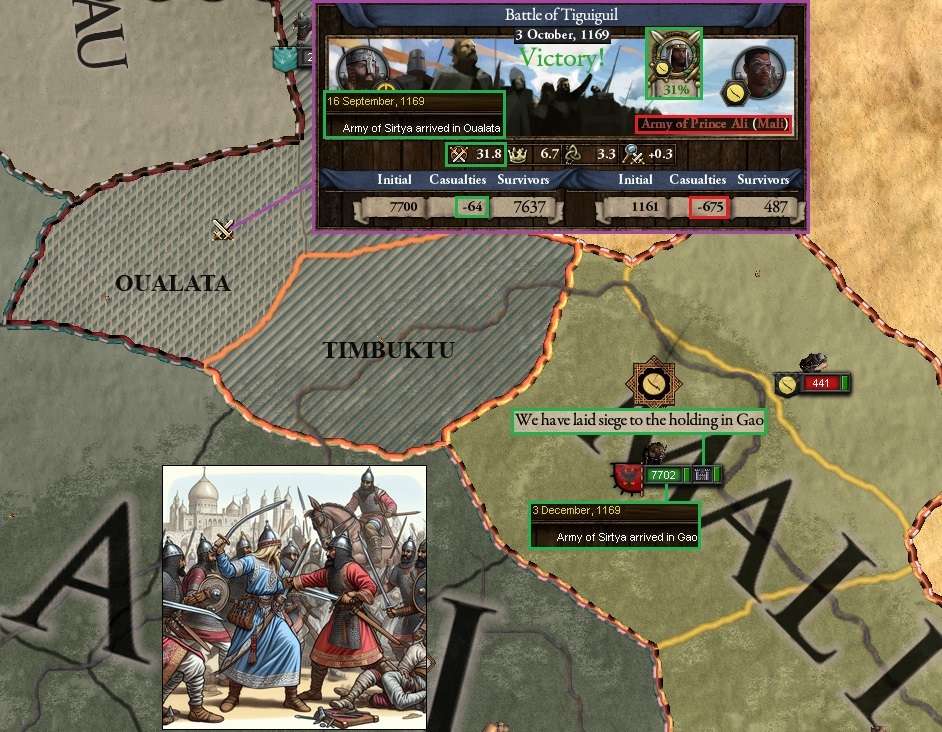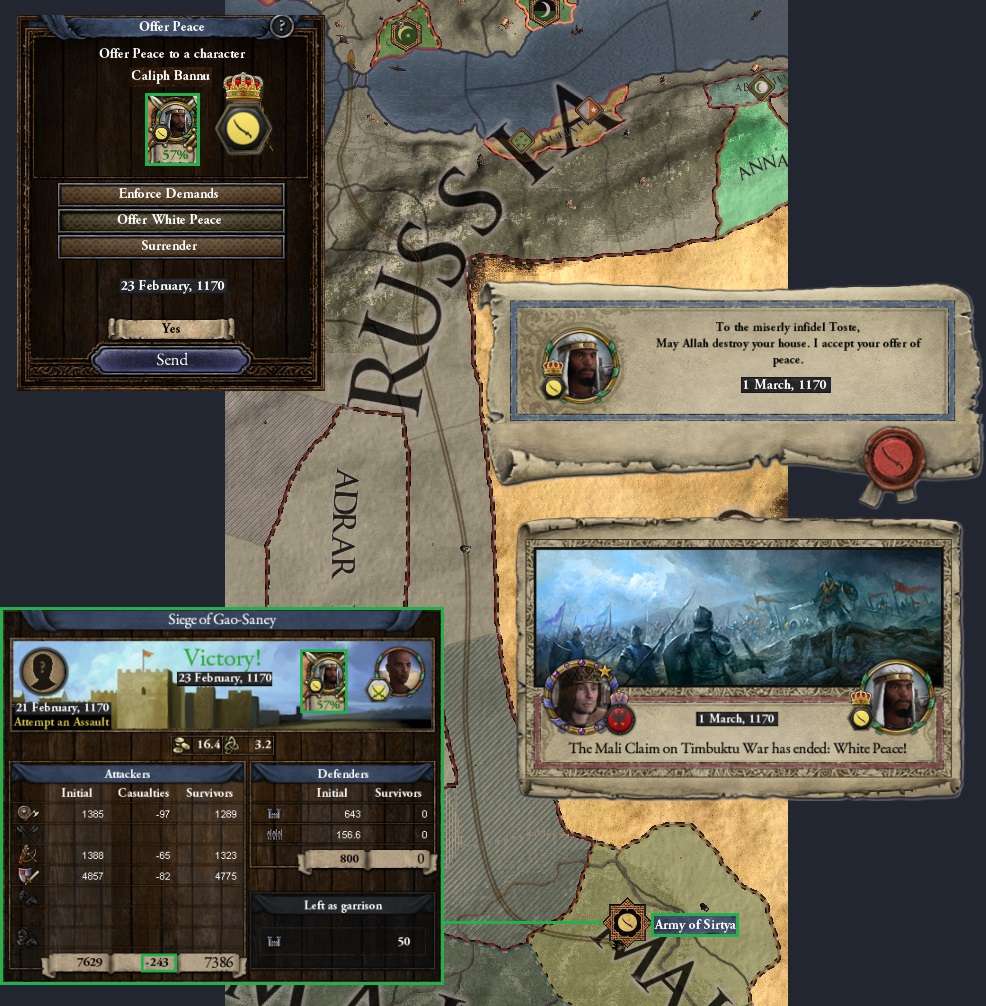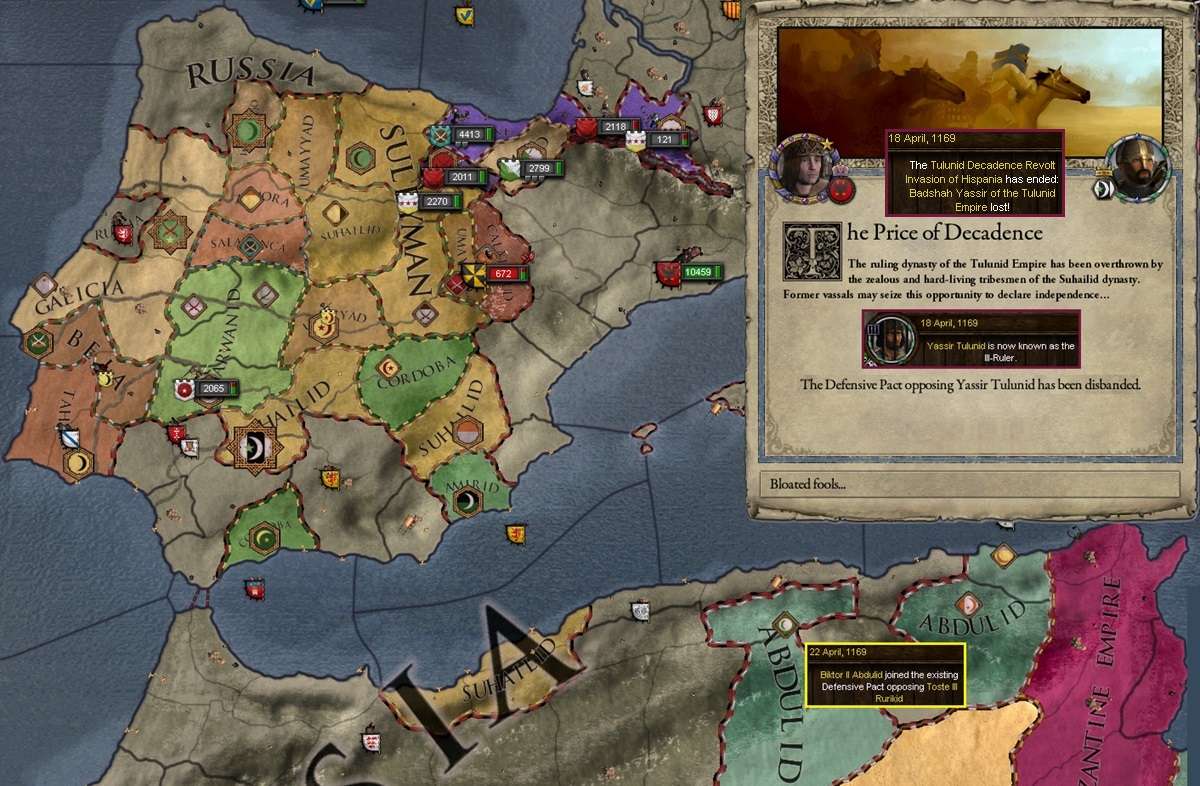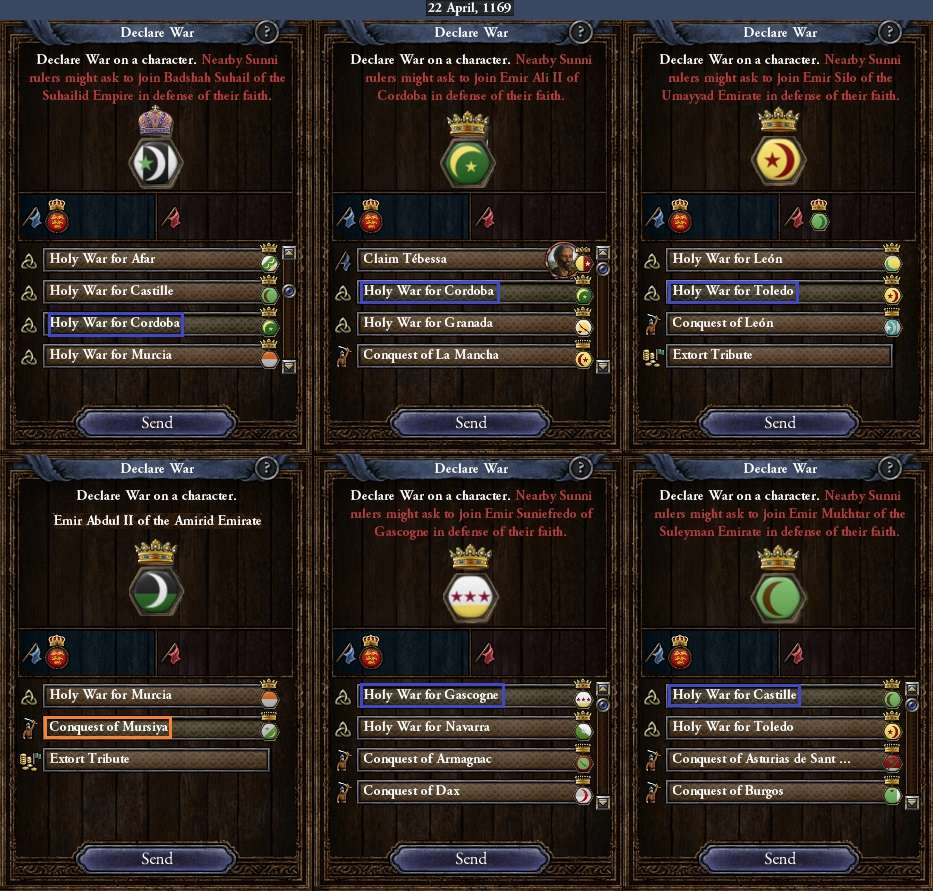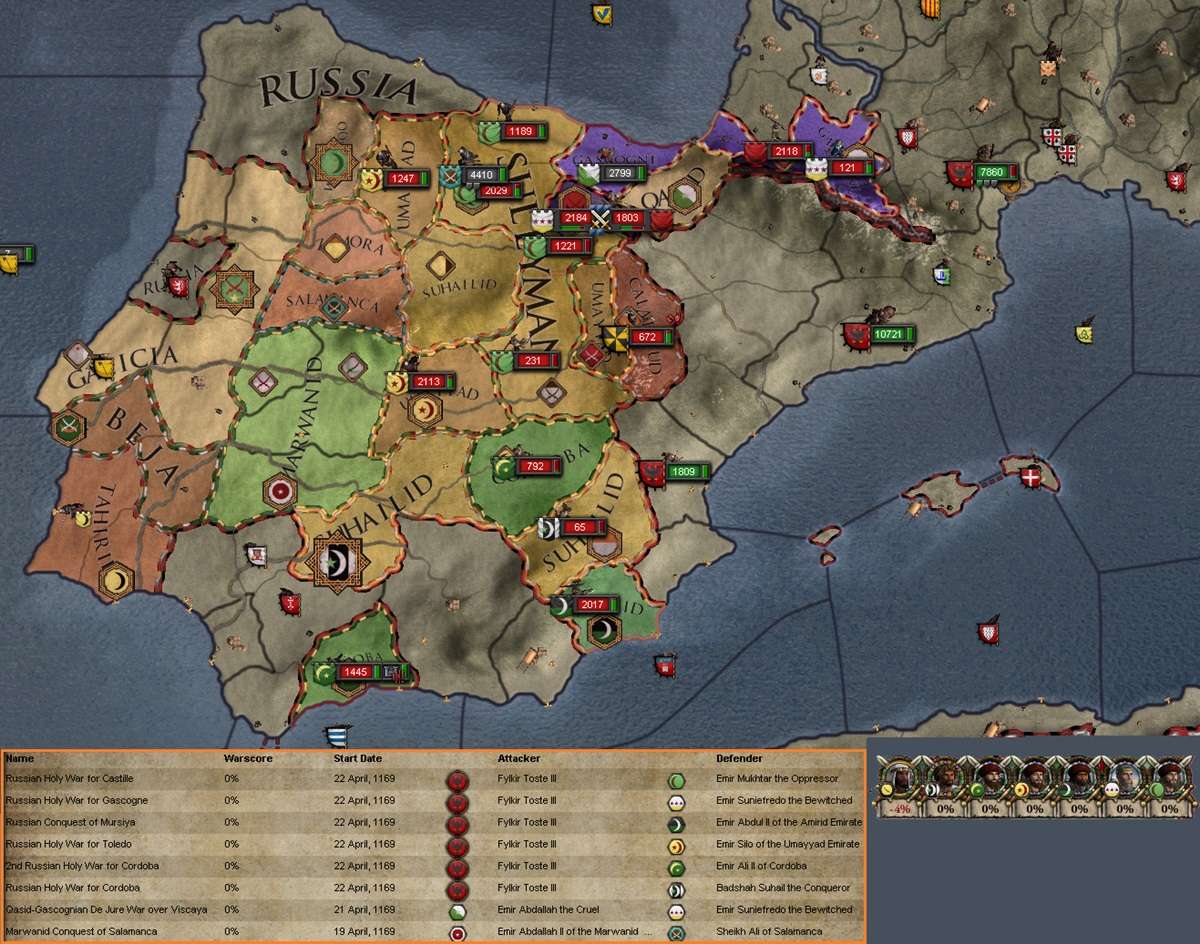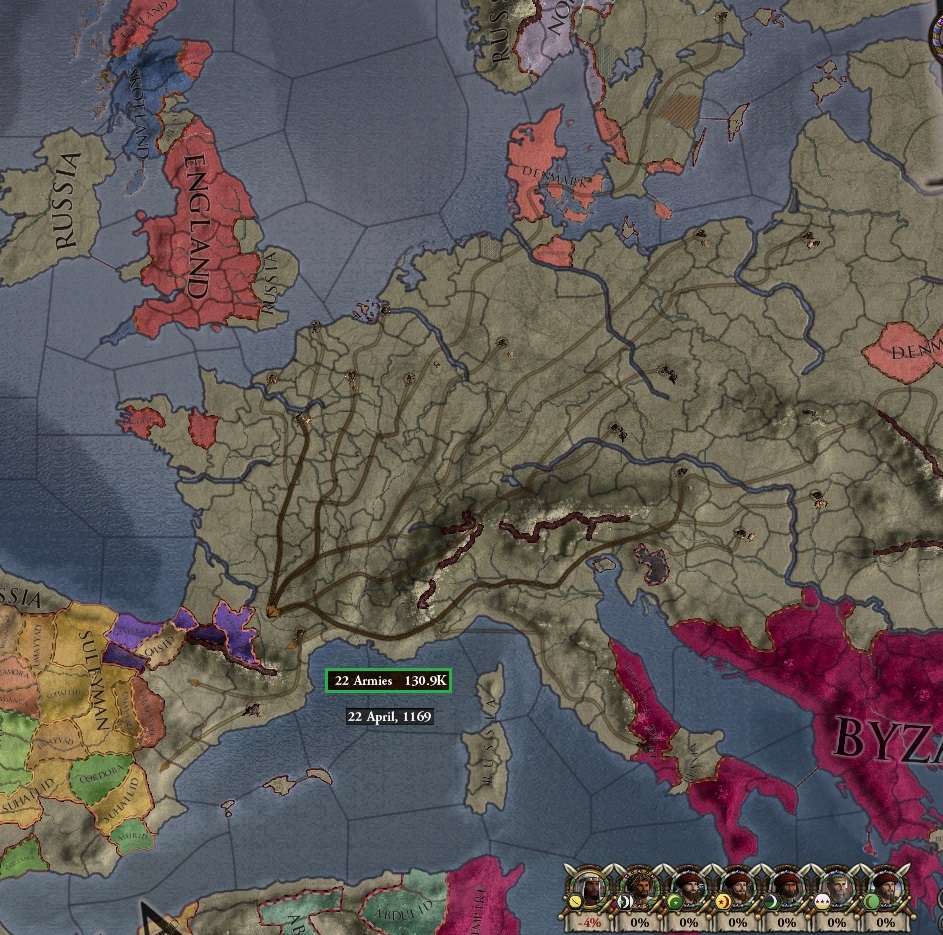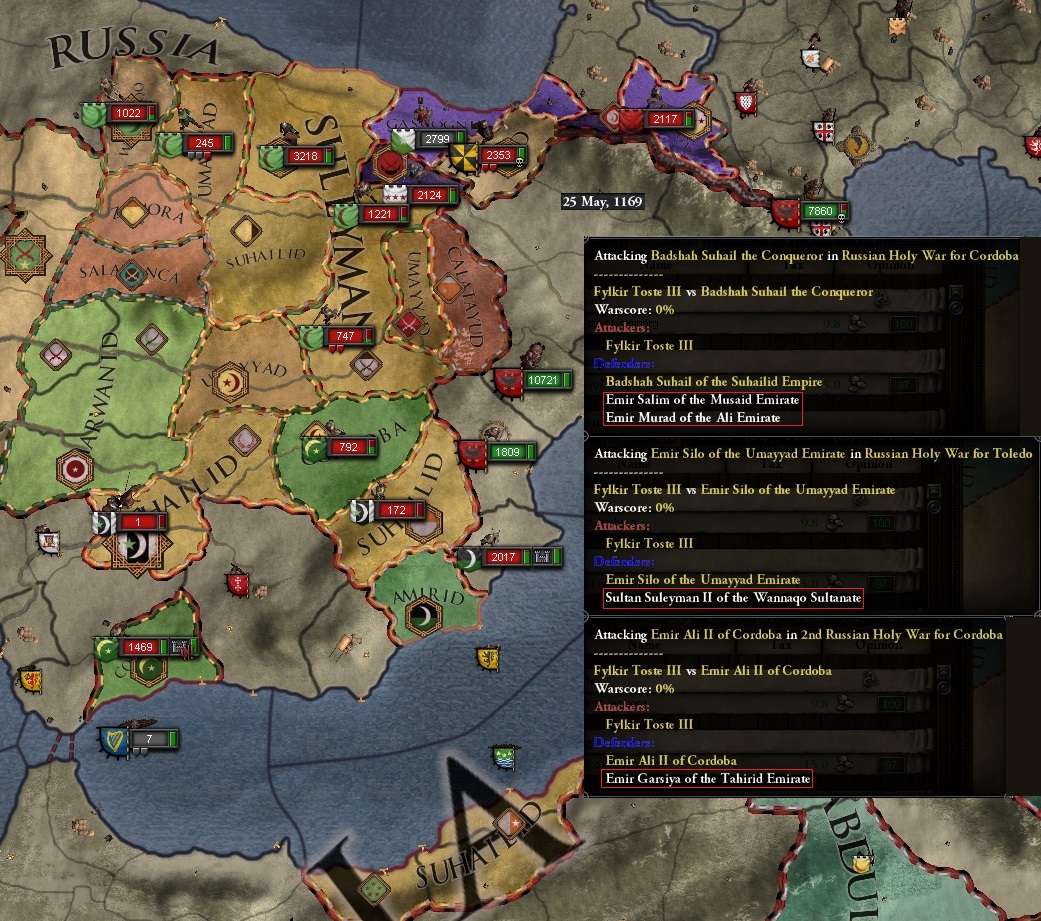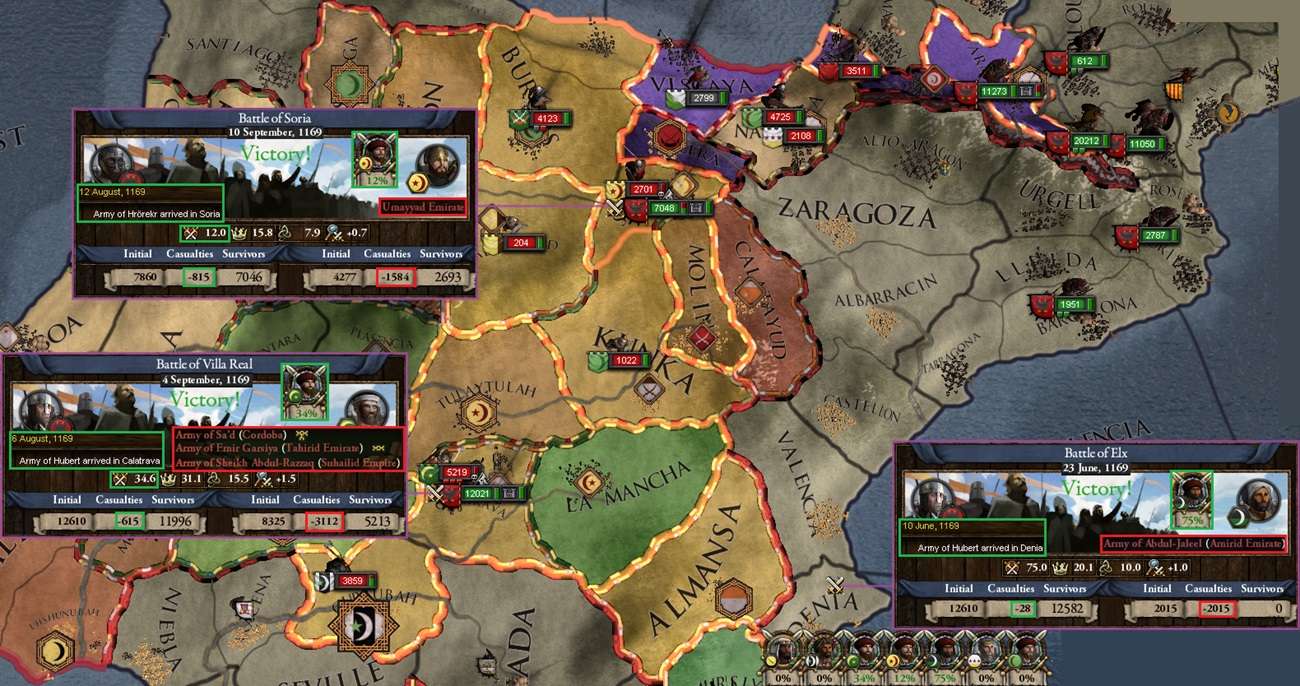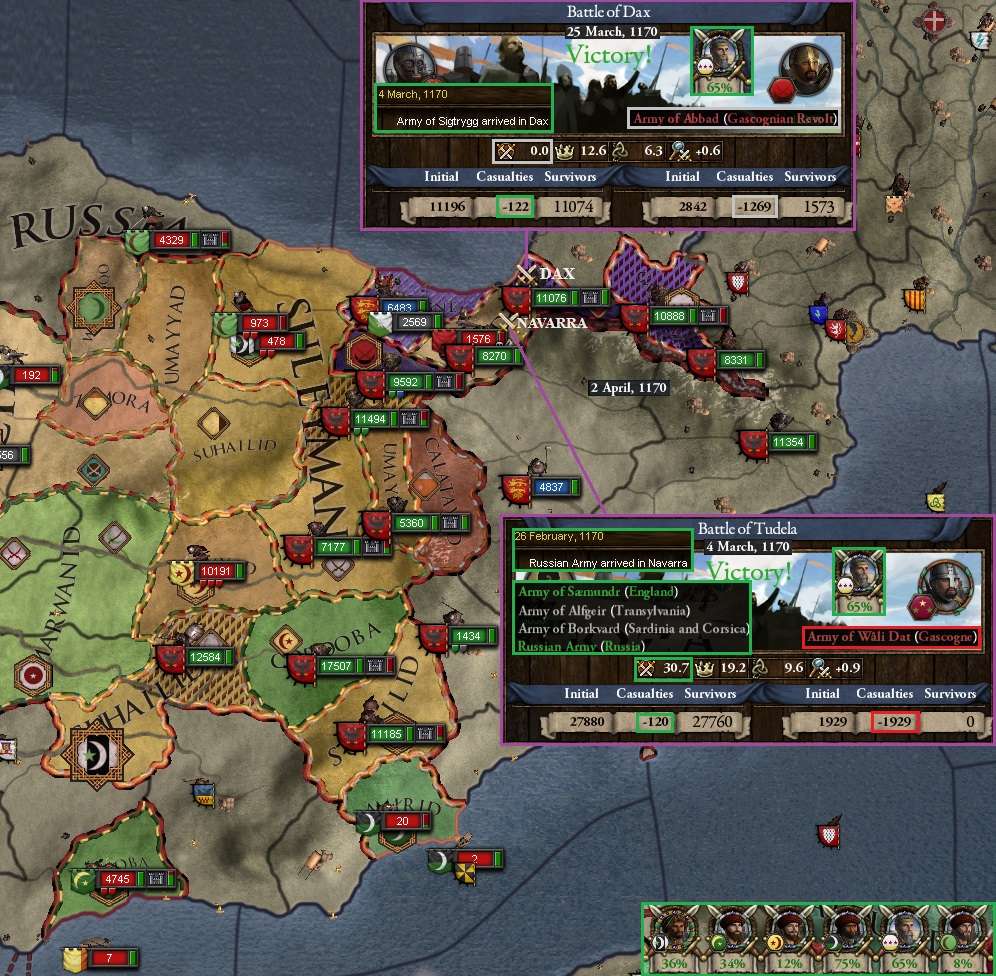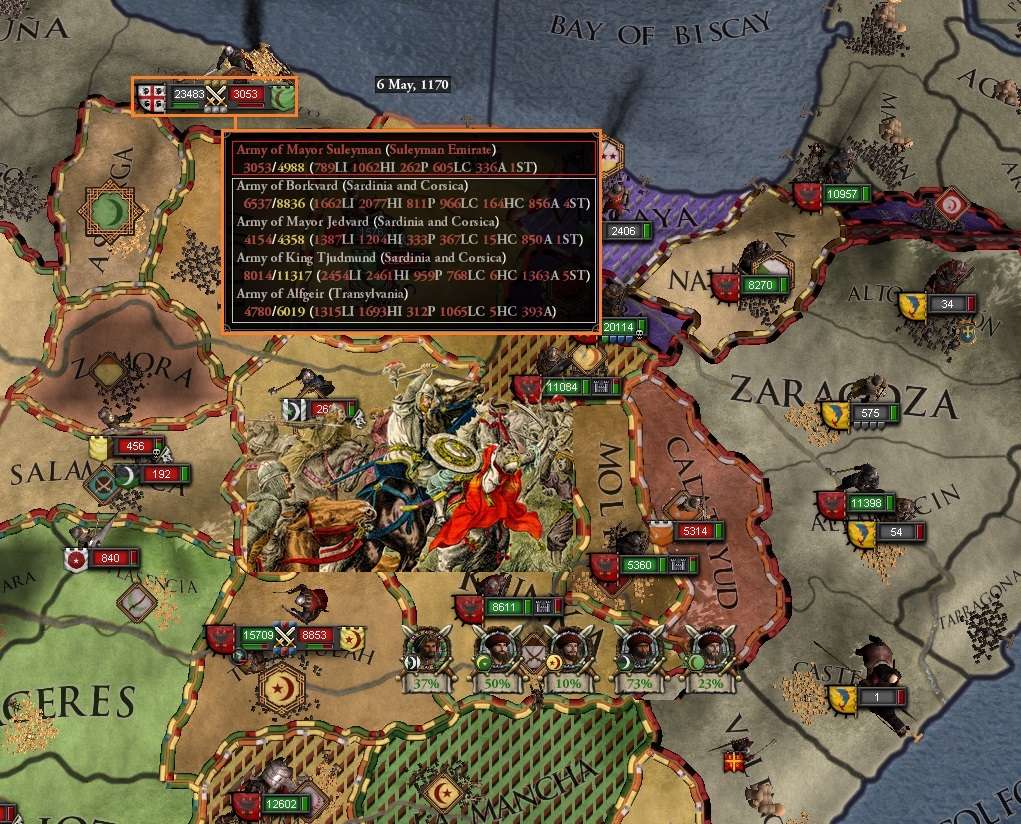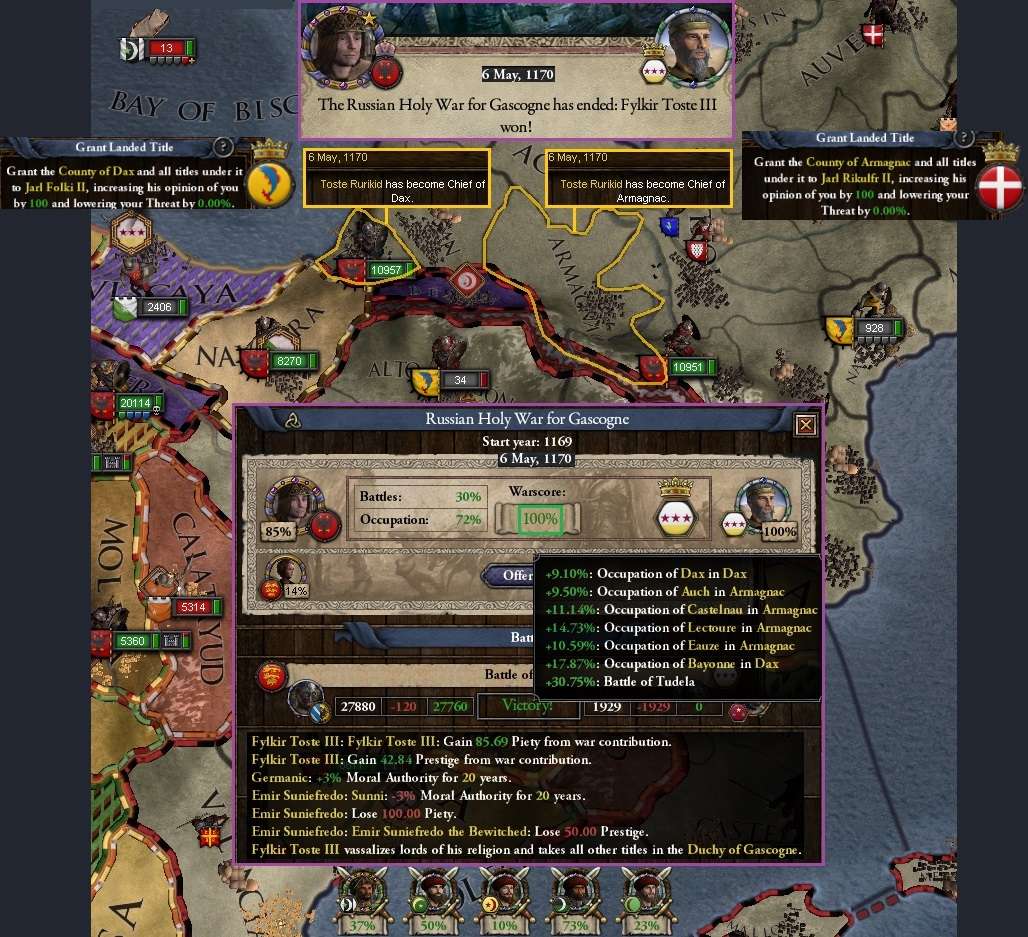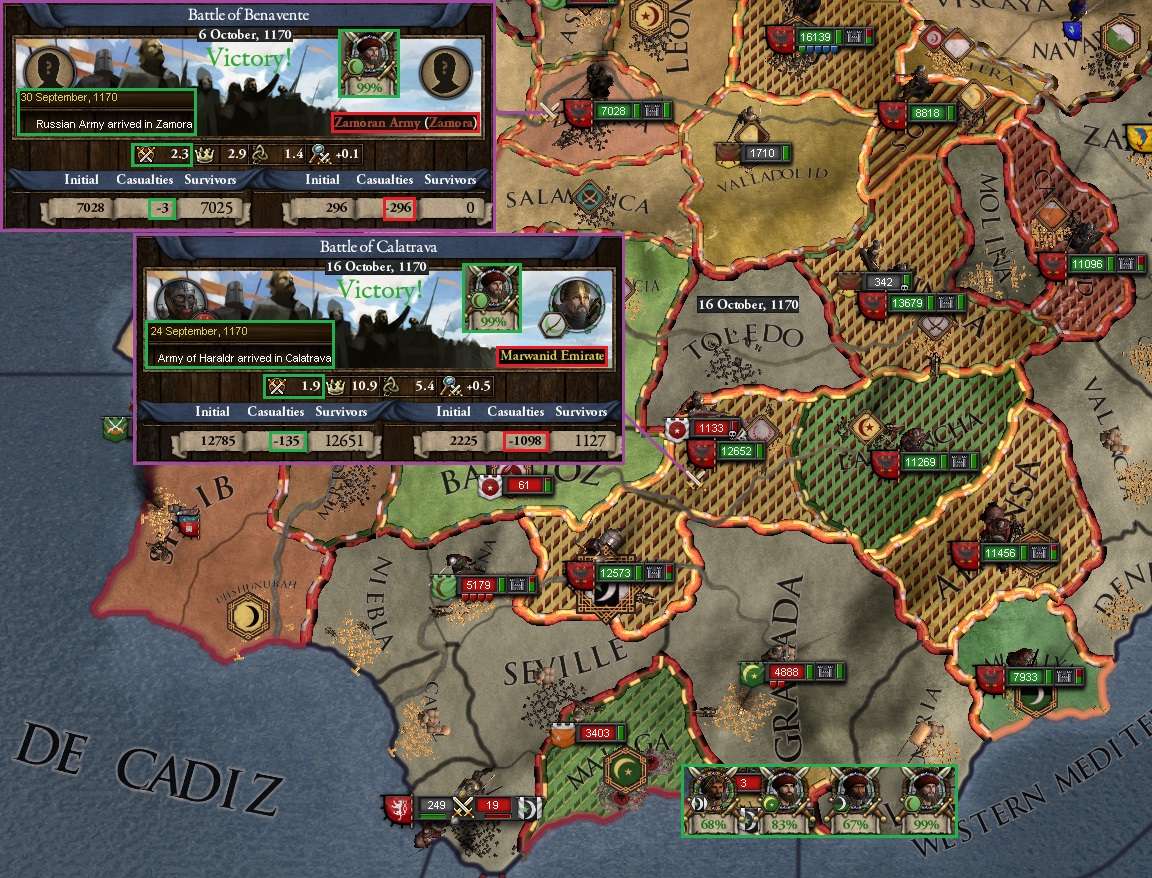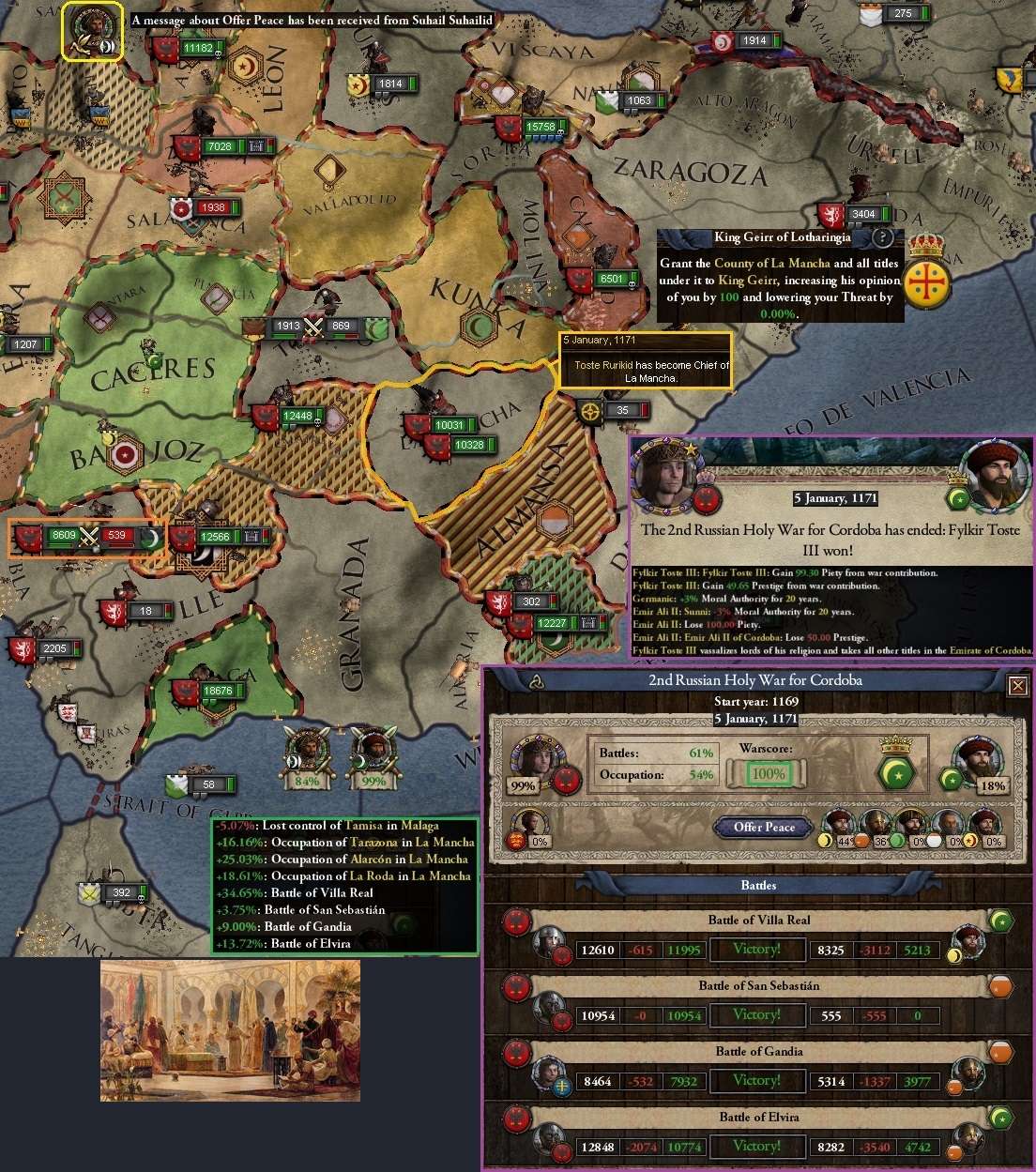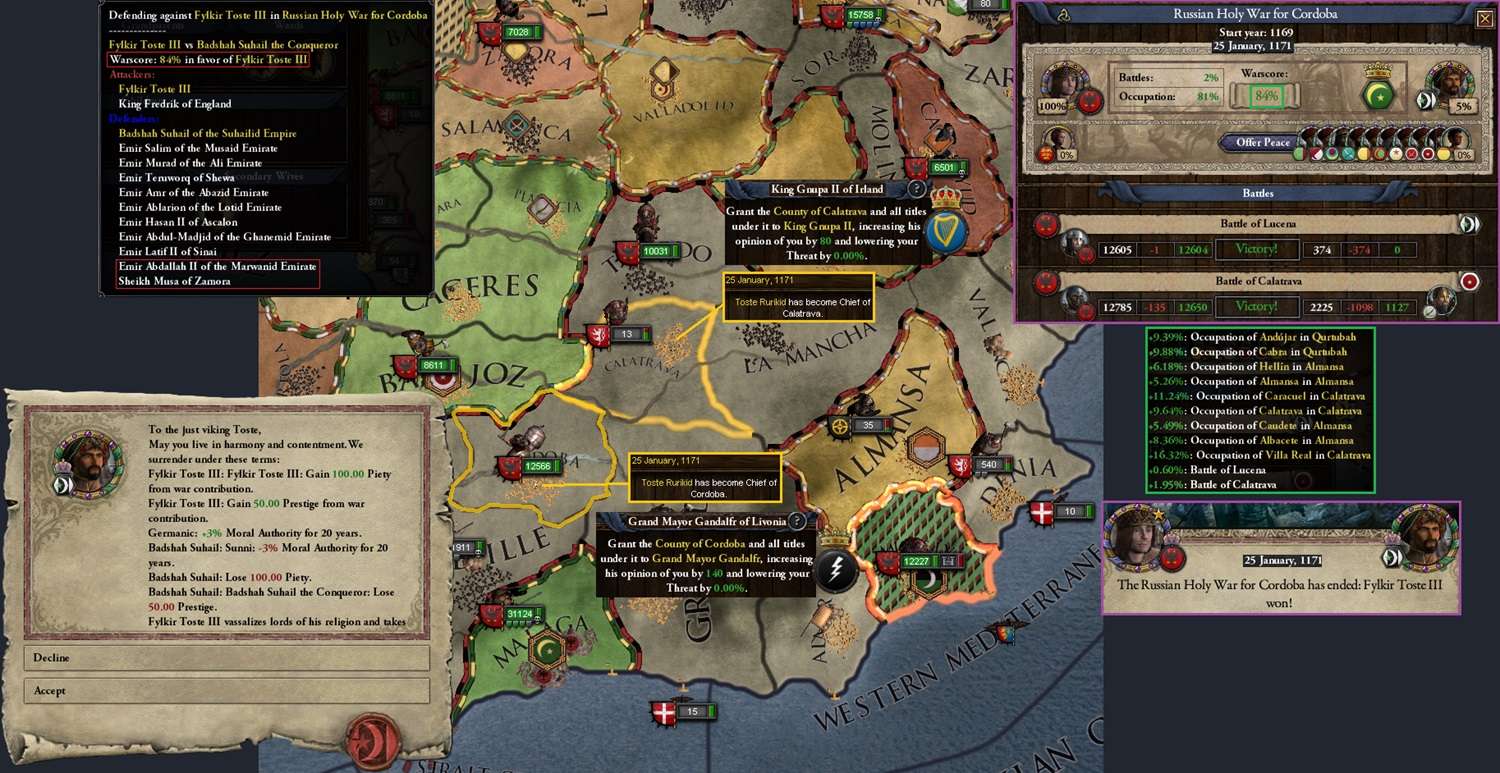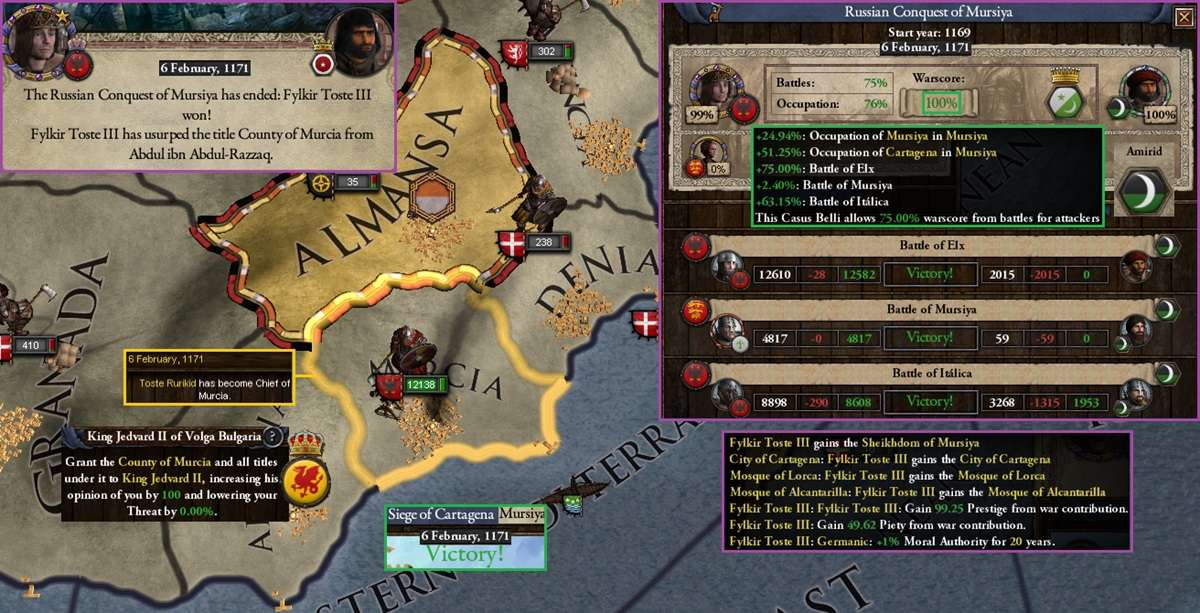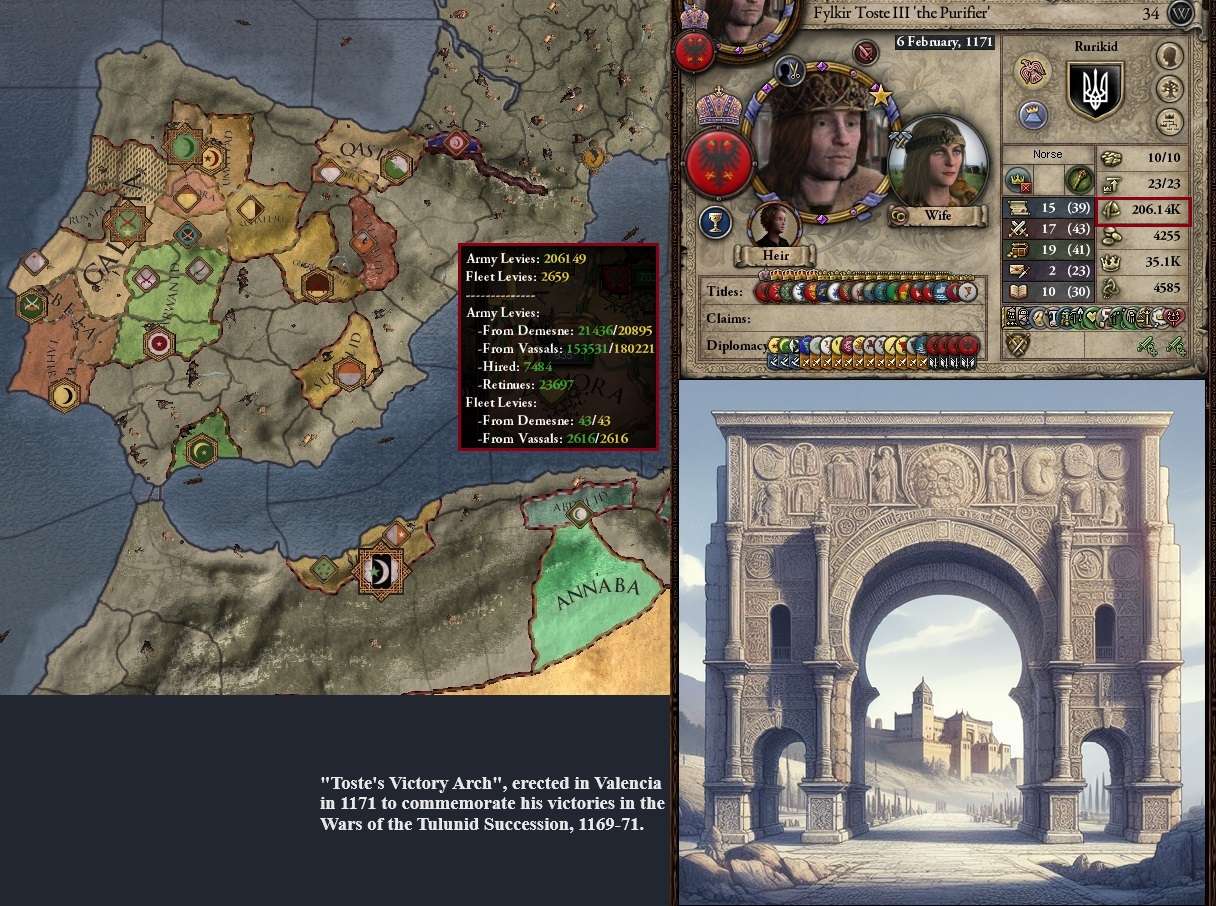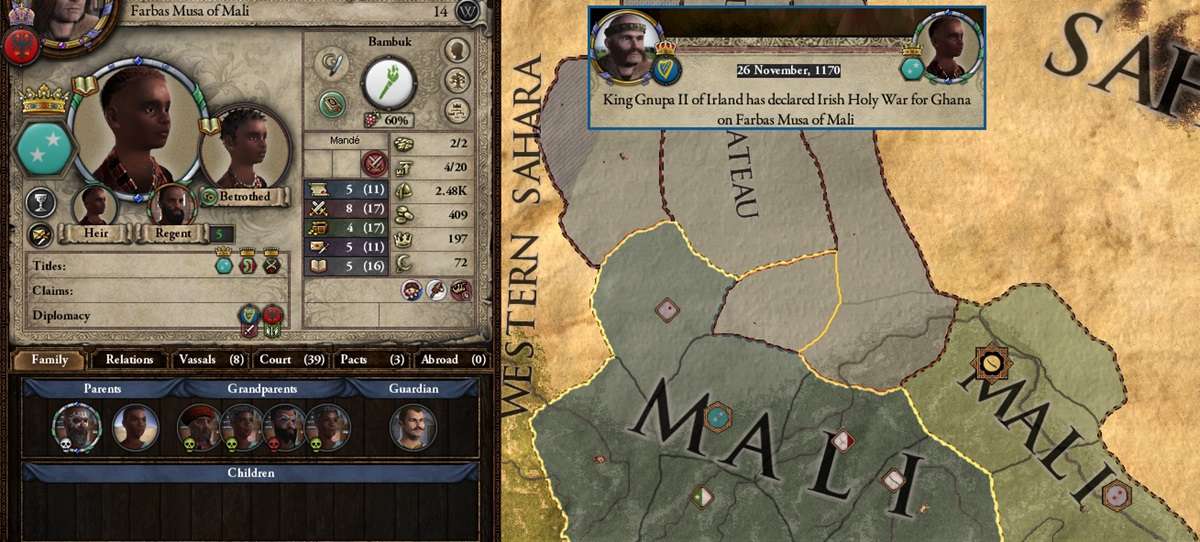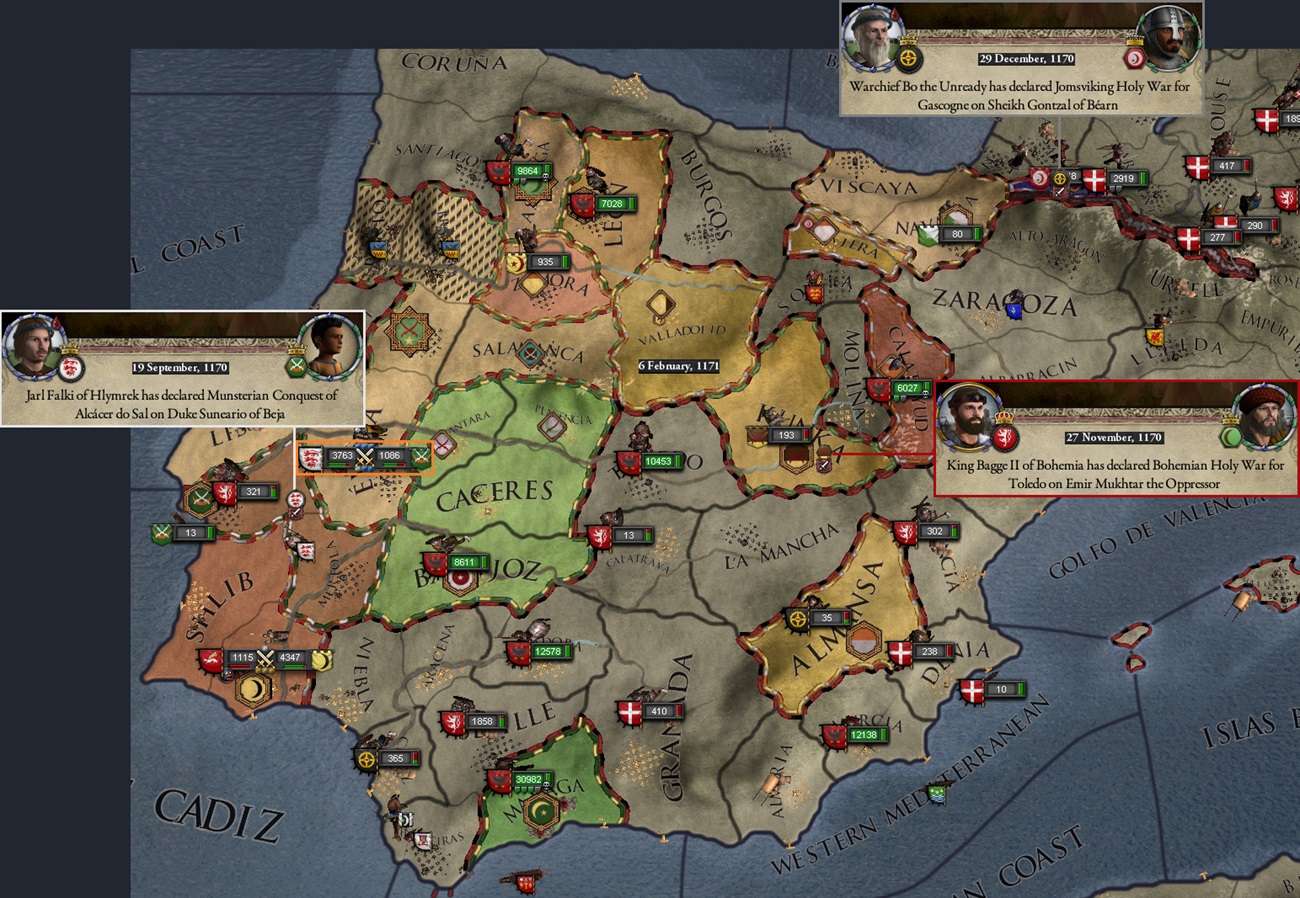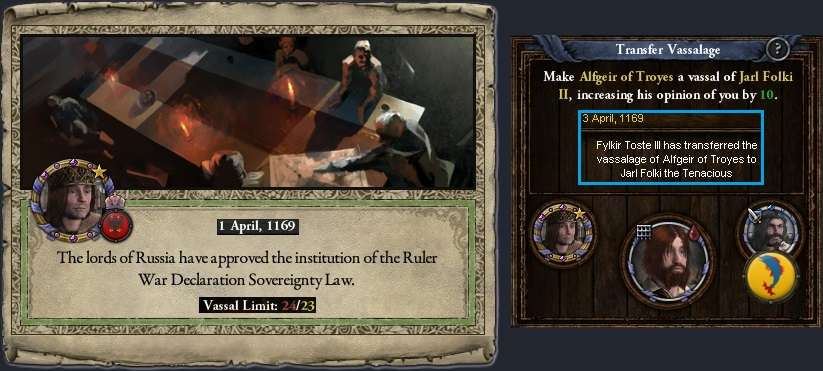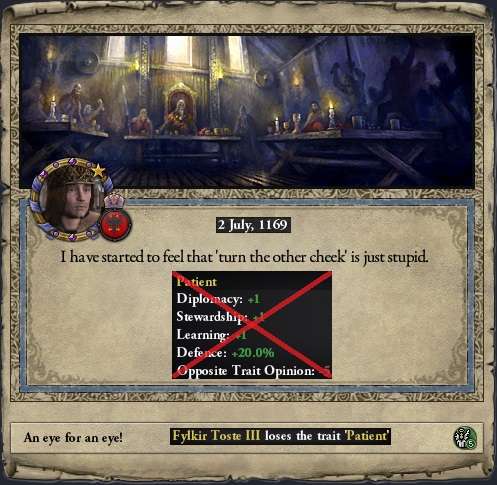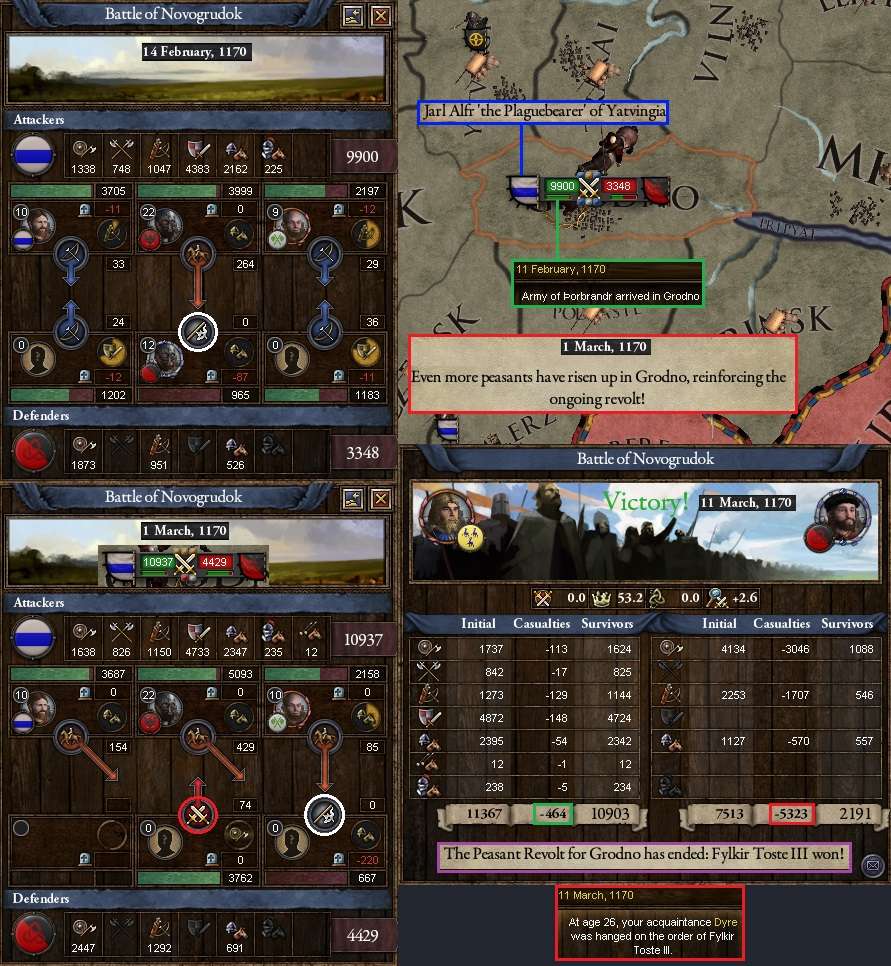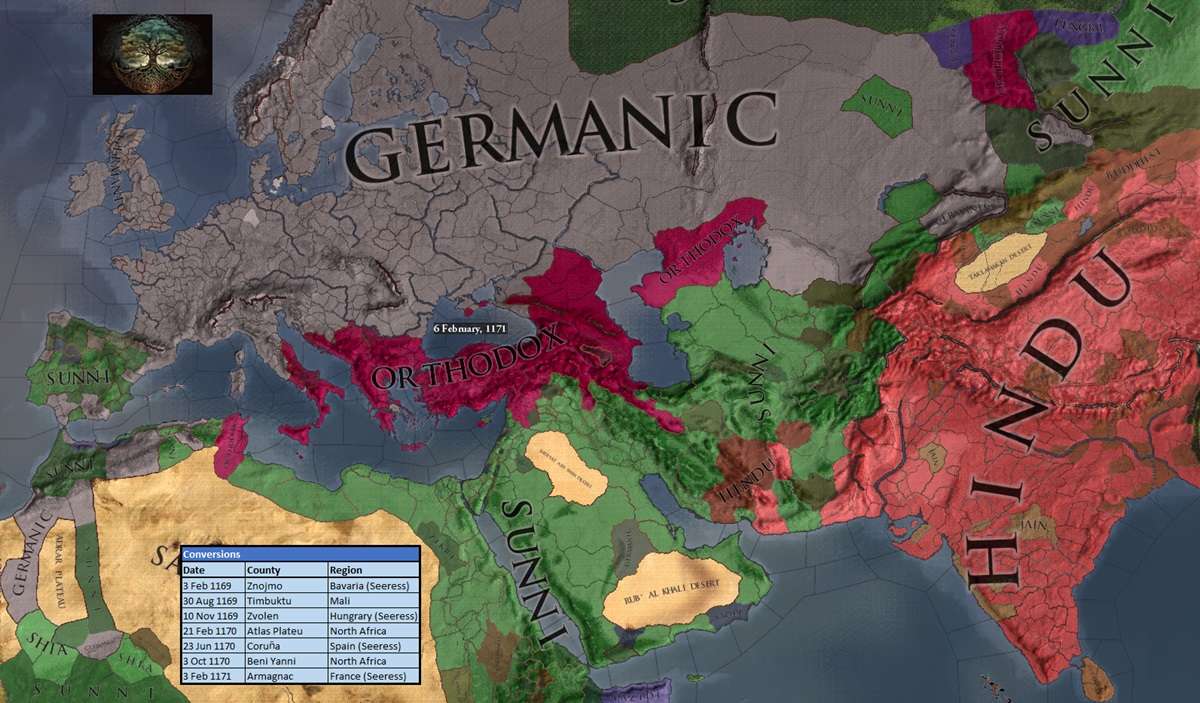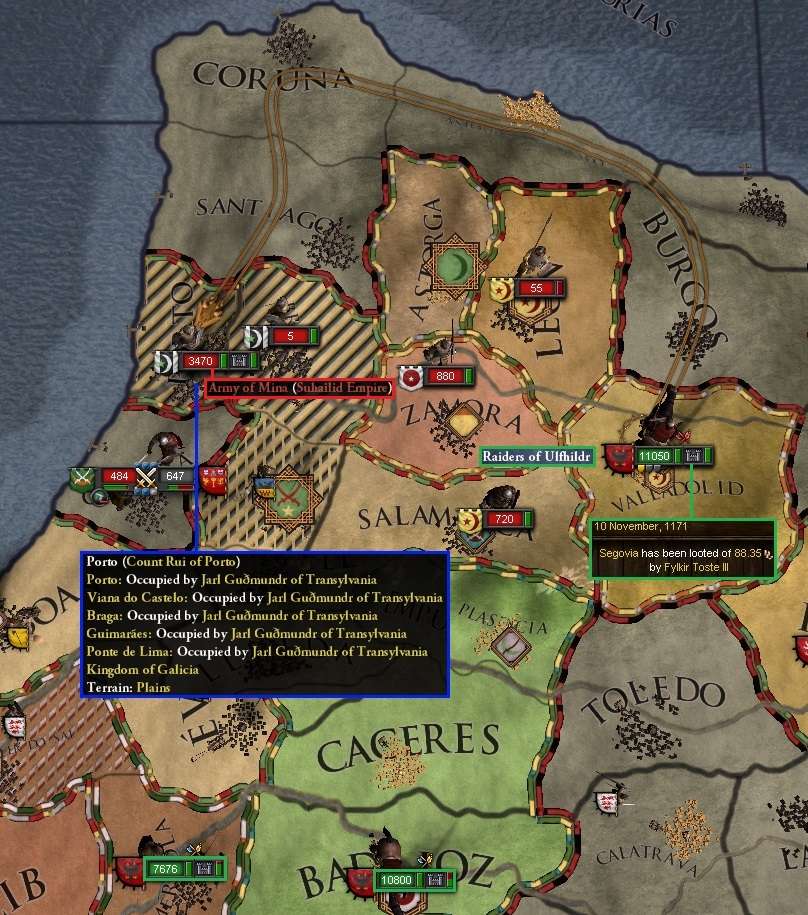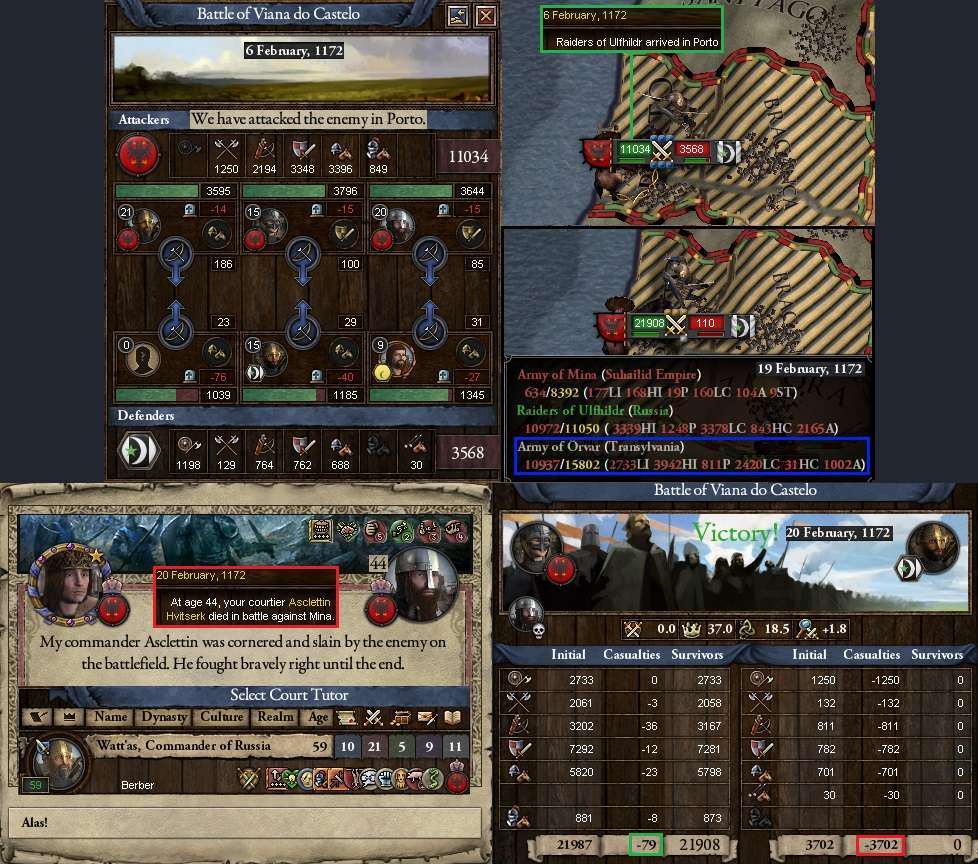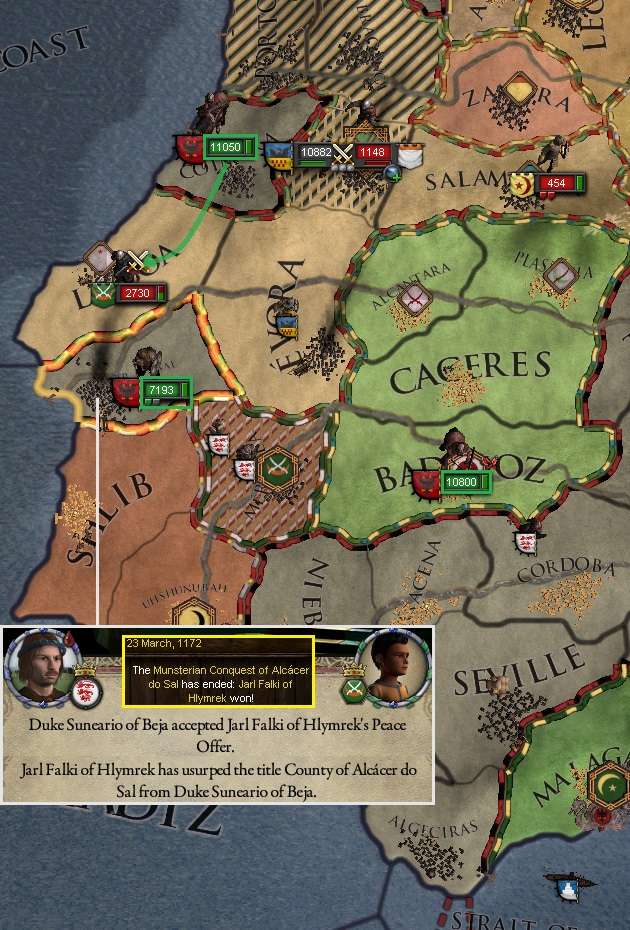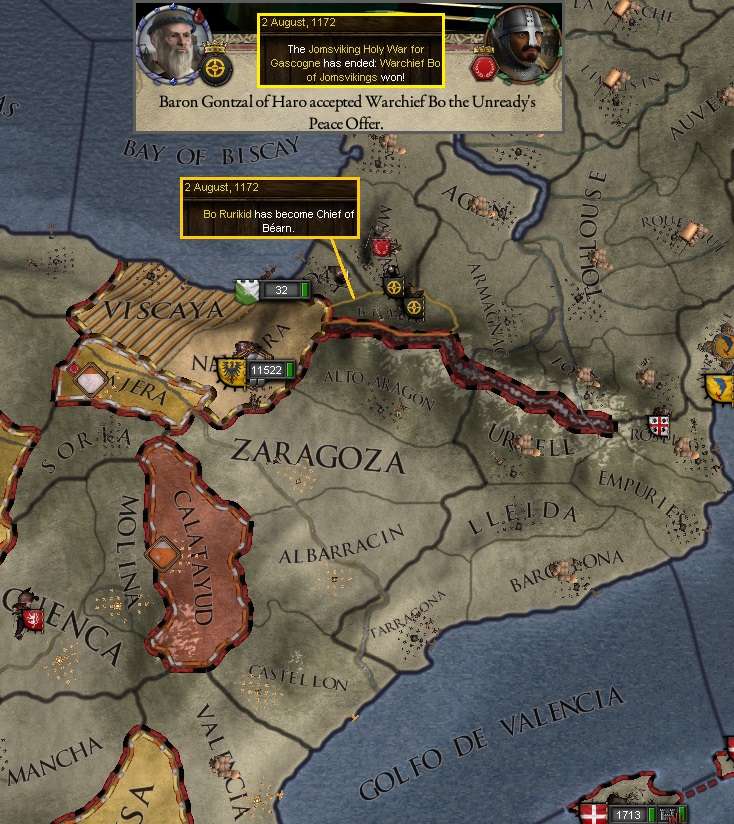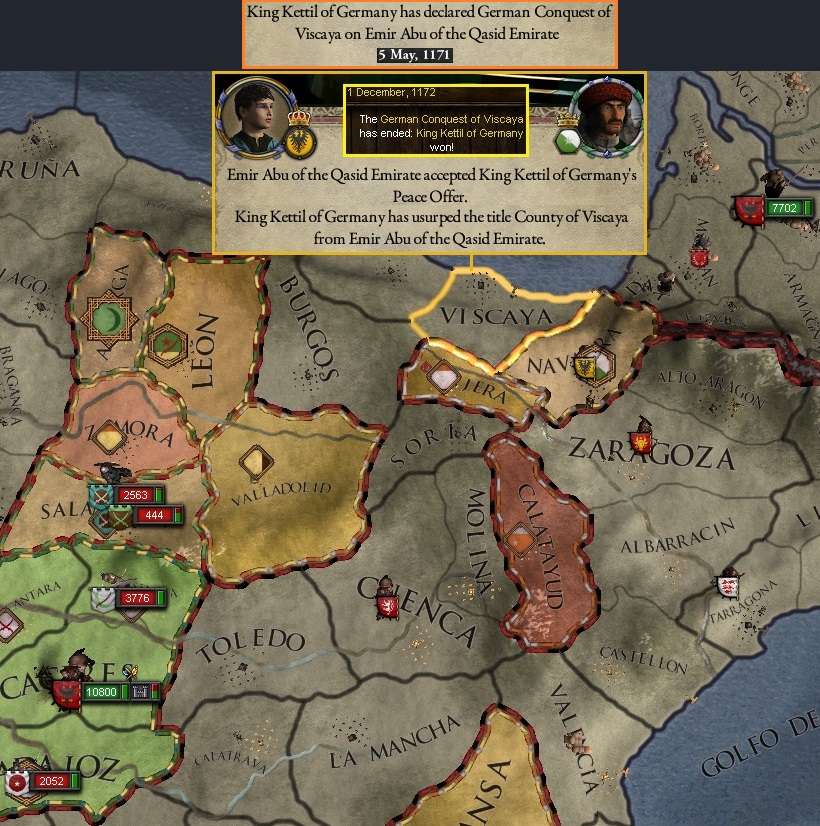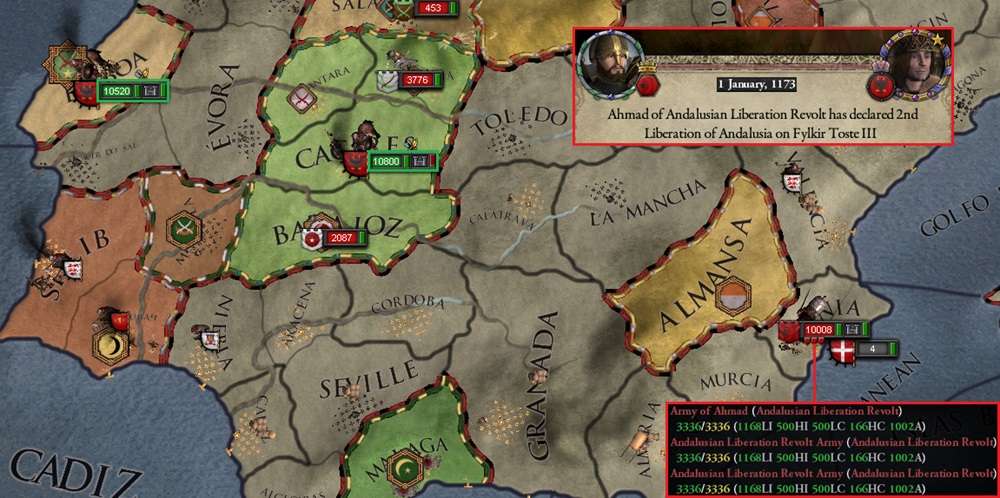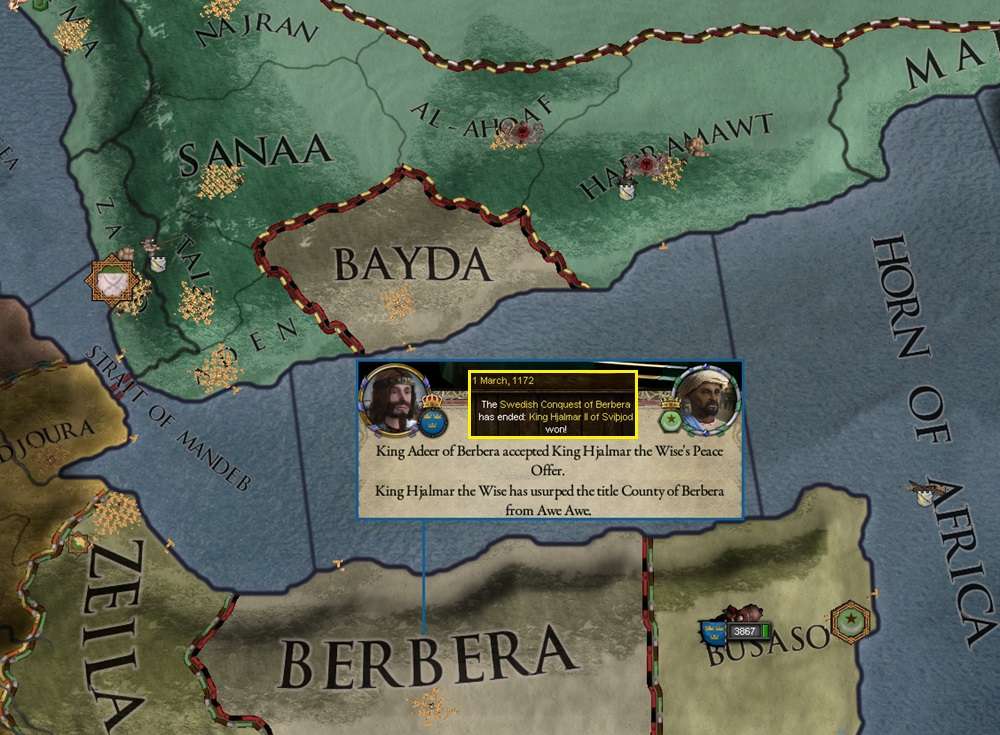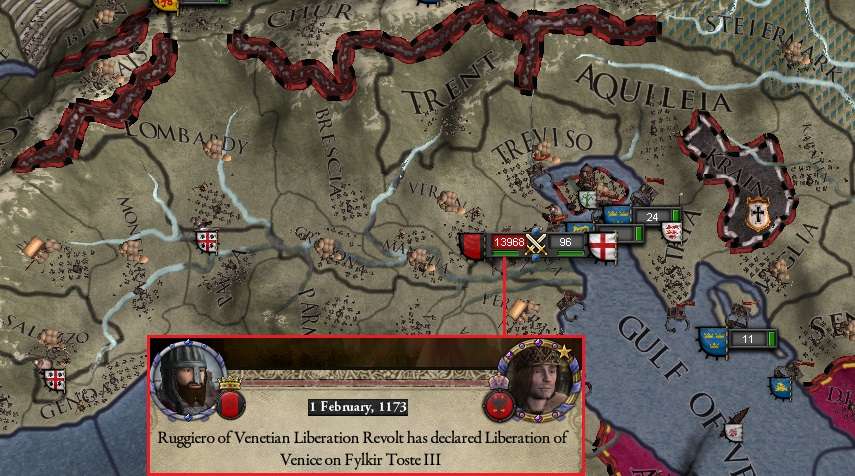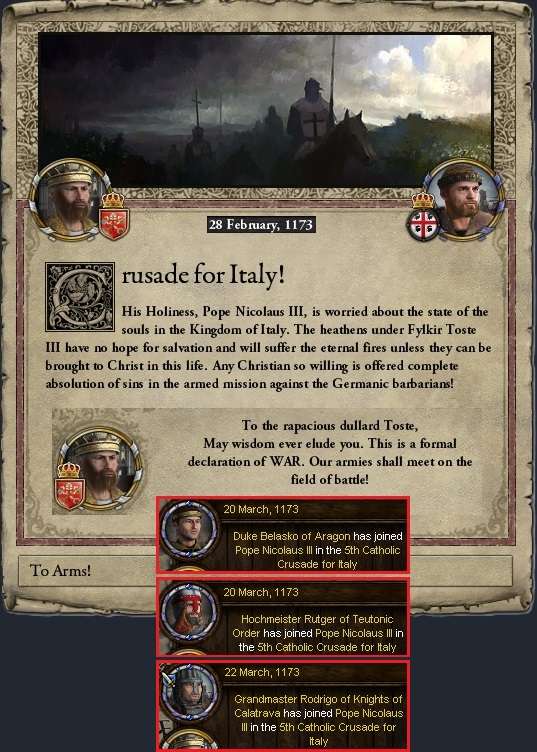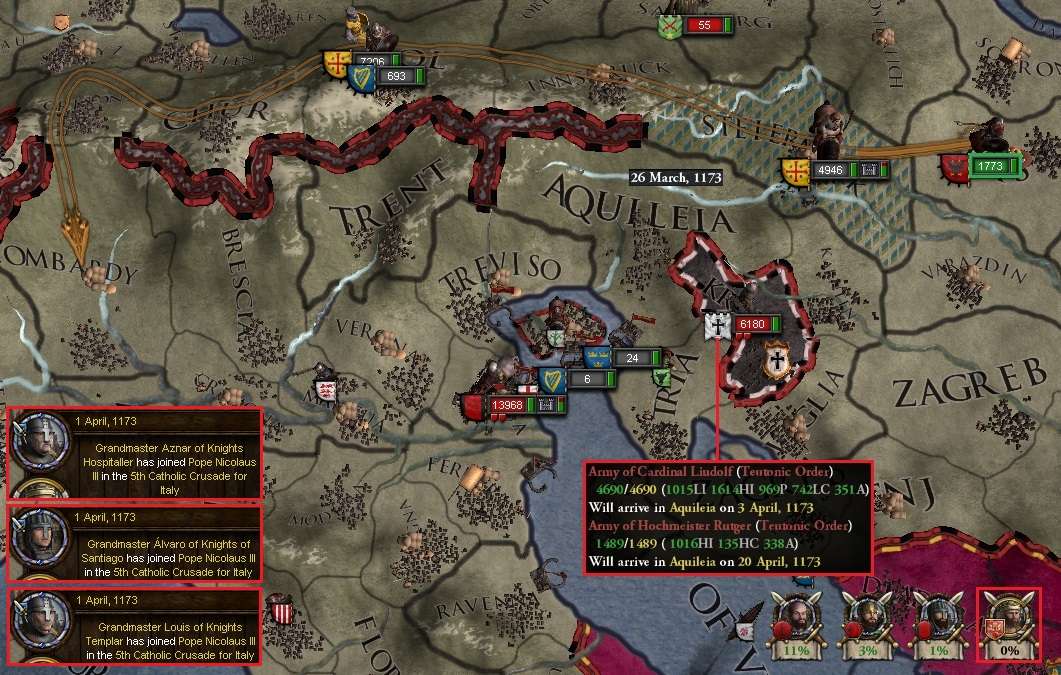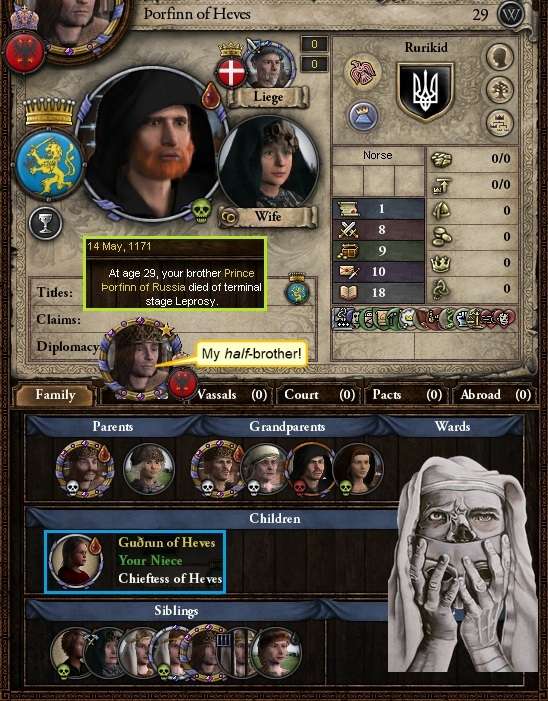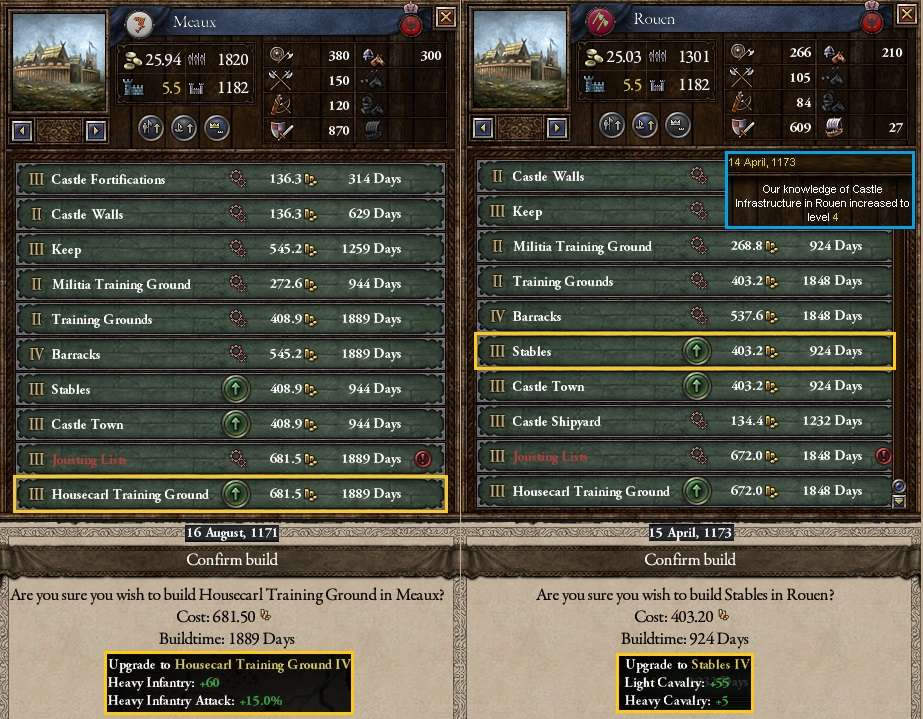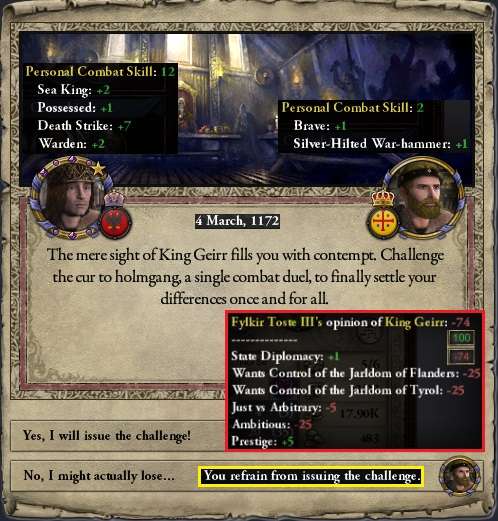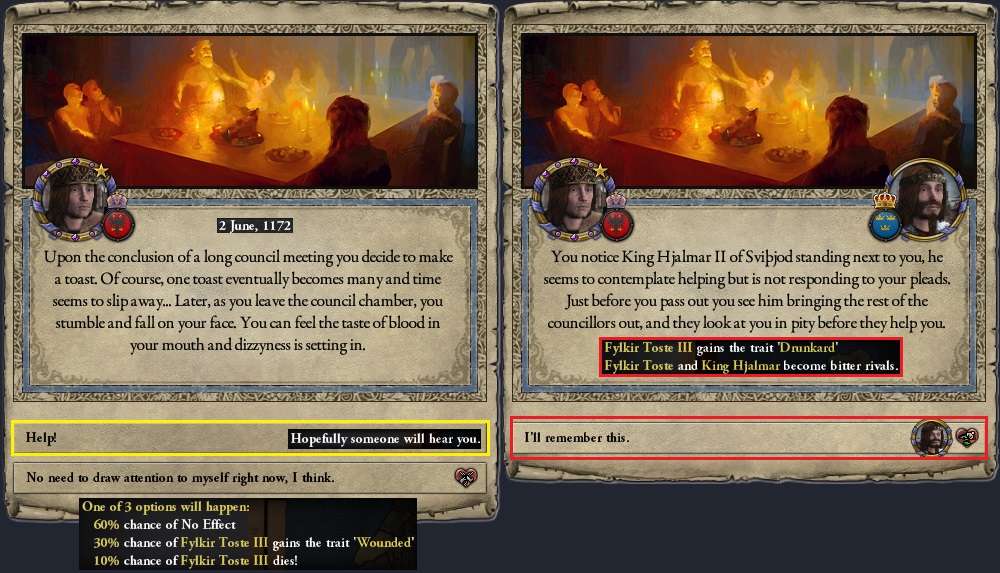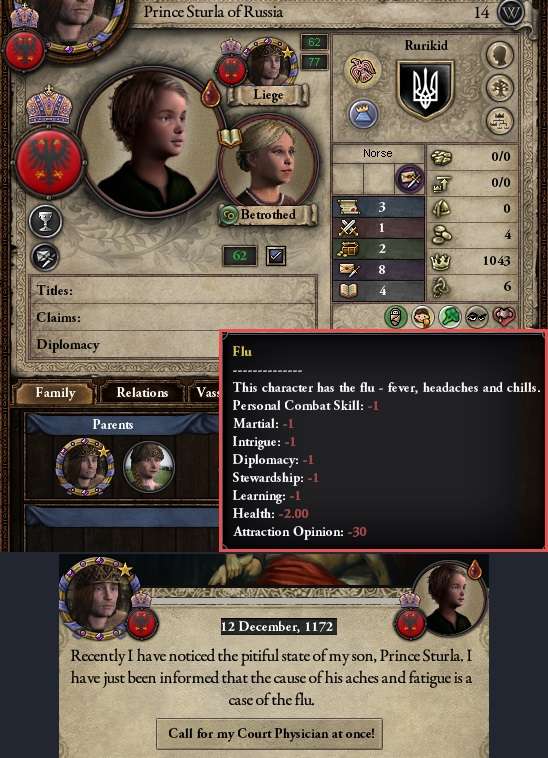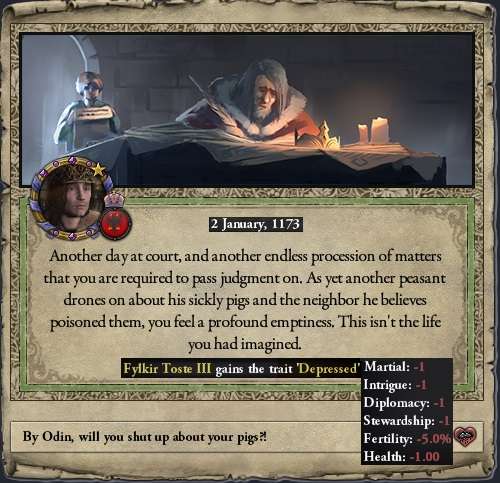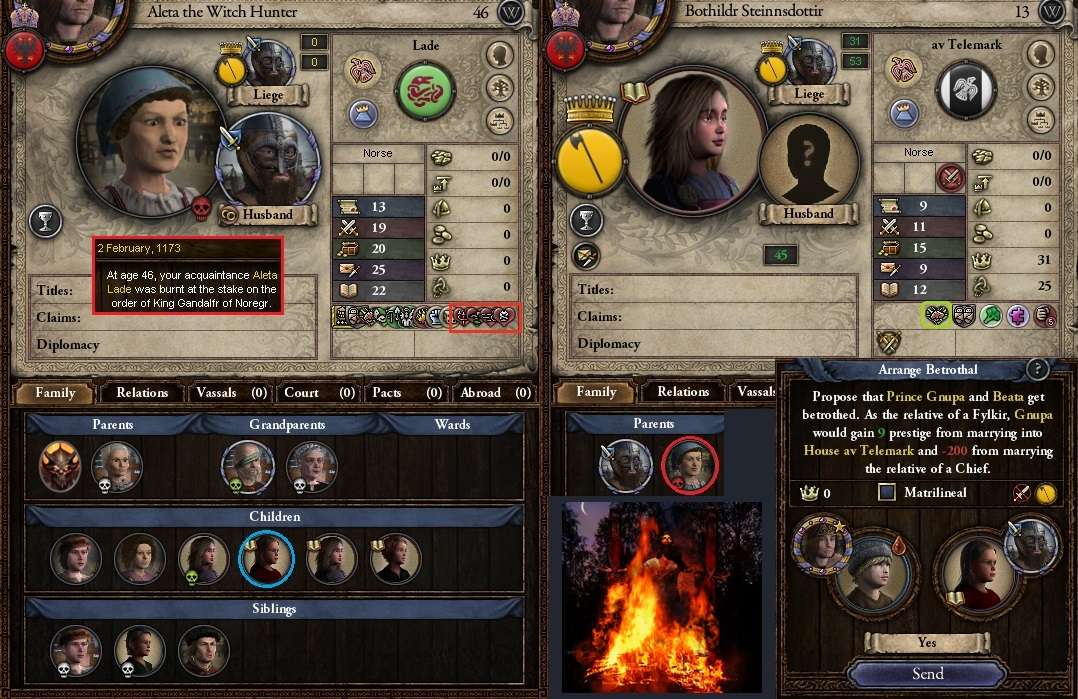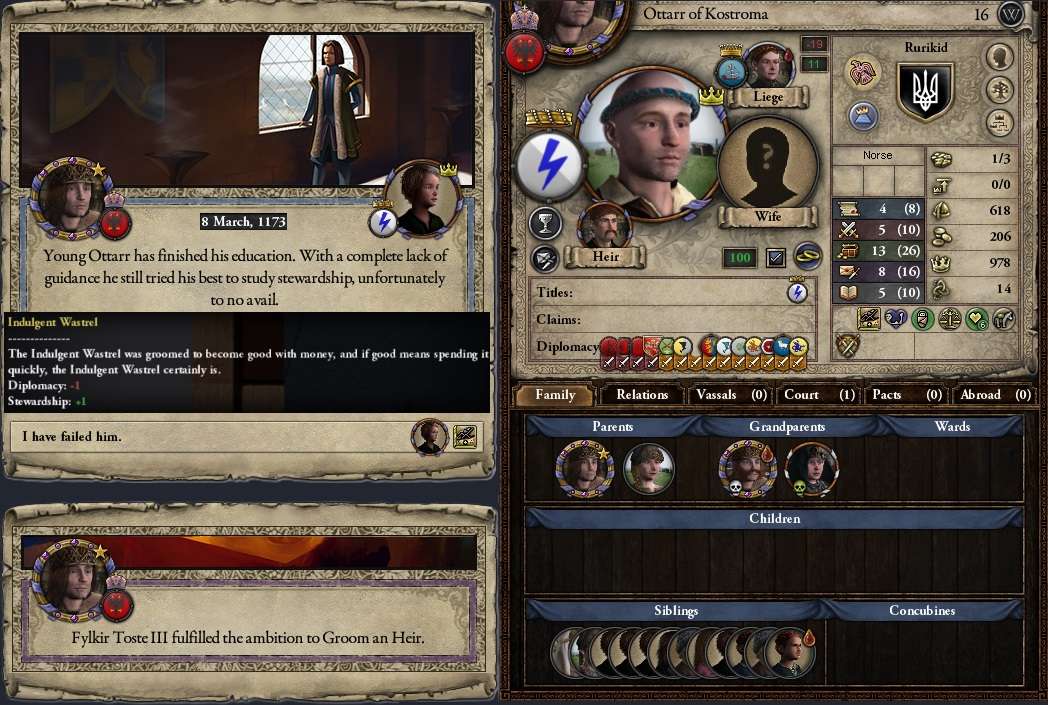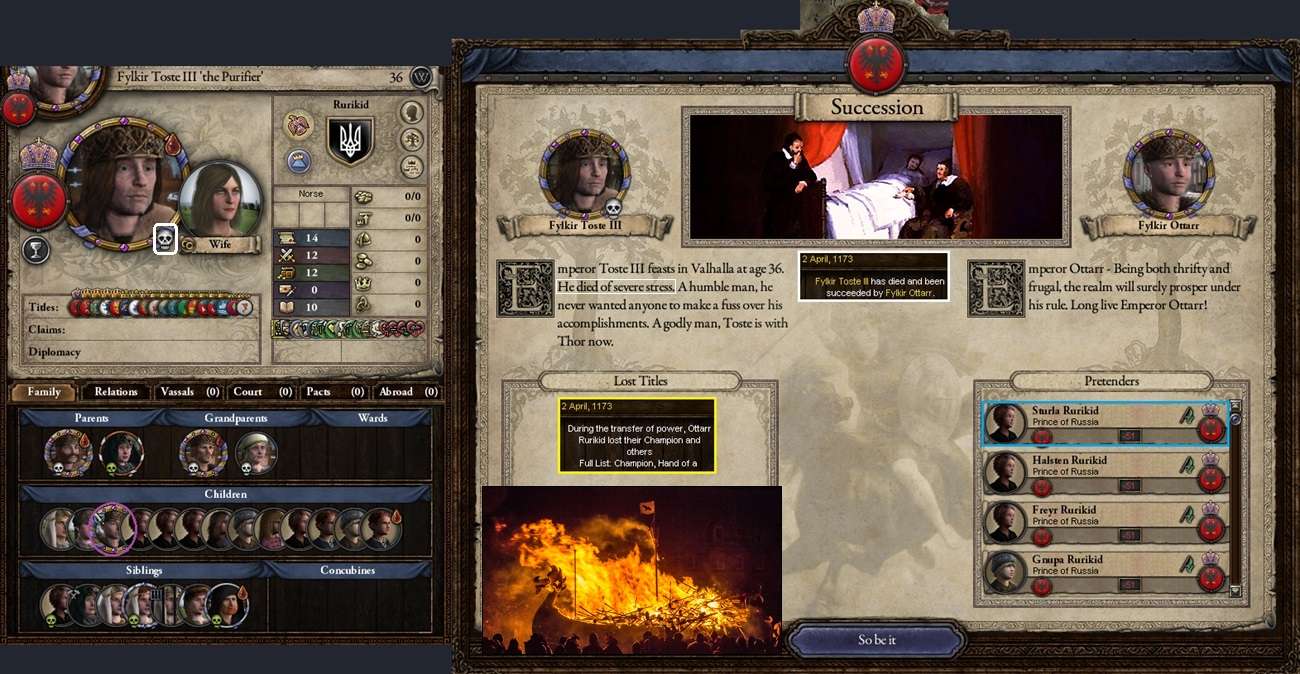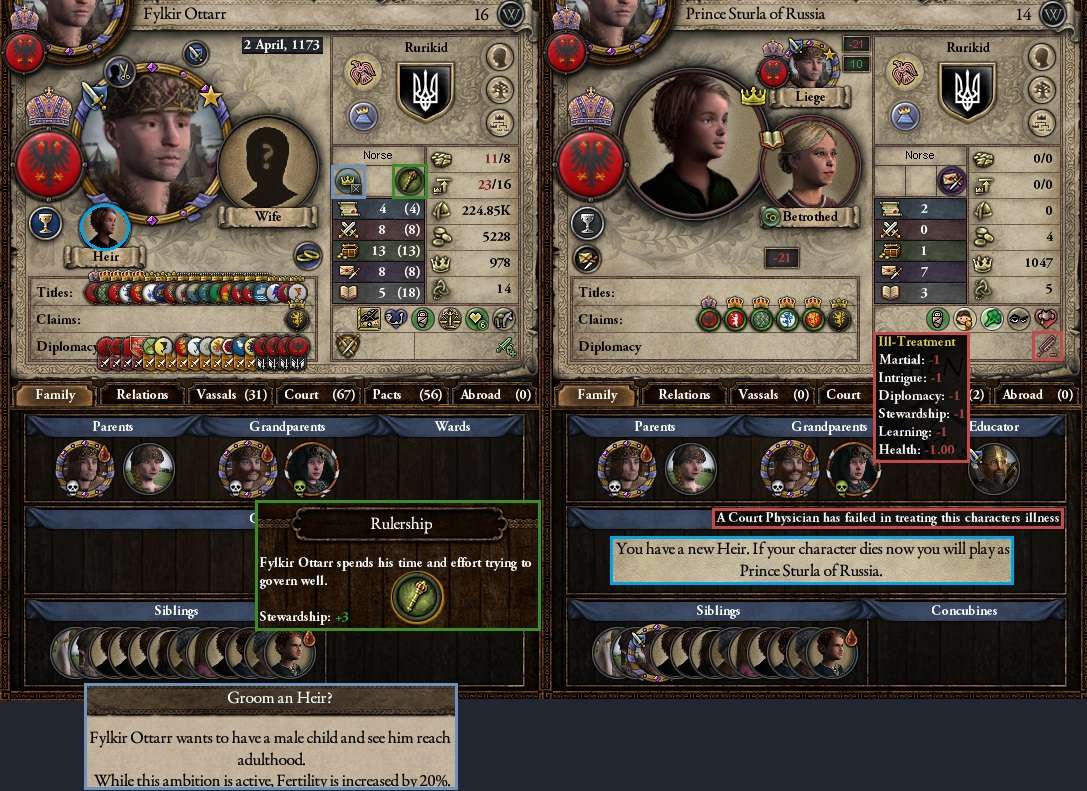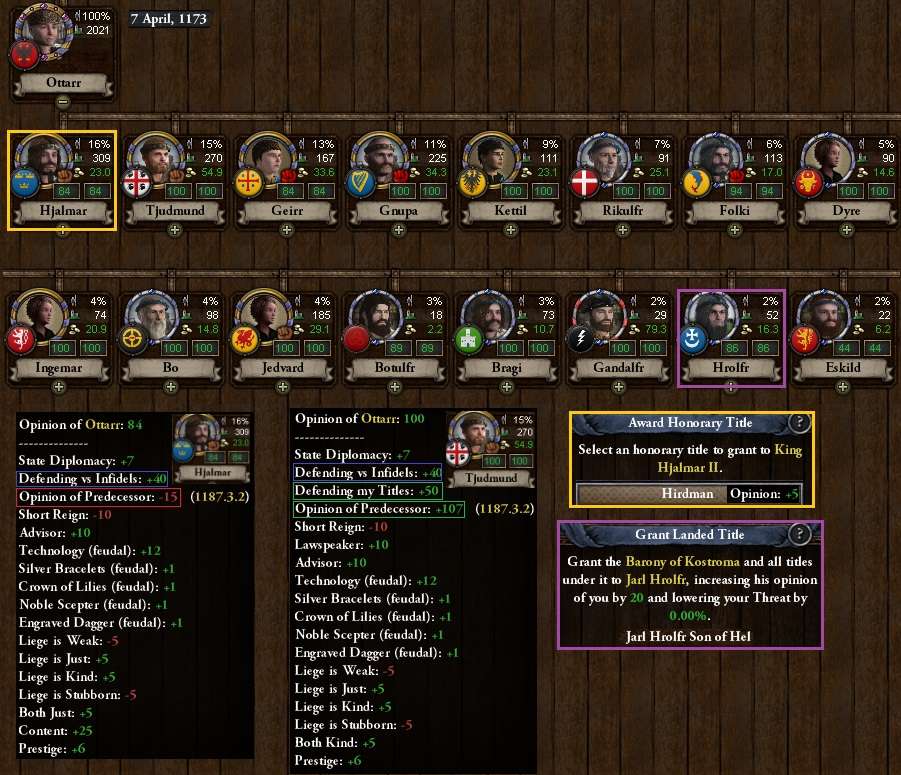Chapter 57: Taken Too Early (1171-73)
ᚔ ᚱᚢᚱᛁᚲᛁᛞ ᚔ
Spain
In the aftermath of the successful conclusion of the Wars of the Tulunid Succession, February 1171 saw the levies on Russian territory quickly disbanded as others marched back to friendly territory to be safely dismissed. By that time, many of the vassal levies had been in service for some time and their lords were getting restless
[up to -10 opinion for 15 or the marcher lords]. It would take some time for the residual resentment to fully dissipate, though Toste’s popularity remained at all-time highs with most due to recent generous land grants.
The remaining retinue (Imperial Guard) and Jomsviking divisions progressively invoked the Sacred Raiding Toggle and set off for a new round of raiding to boost the treasury, with Badajoz (16 February), Valladolid (11 March) and Mértola (6 April) being the initial targets.
On 3 May, two more retinue companies (one shock and one cavalry) were raised in the capital following on from the recent expansion in Spain. Two days later, young King Kettil of Germany launched a new war of conquest for Viscaya, on the northern Spanish coast.
As the raiding continued without meaningful interruption, the Russian vassal levy base gradually recovered from the war time casualties, reaching full capacity by late August 1171 (around 181,000 vassal levies; 234,000 troops from all sources).
On 10 November the raid of Valladolid was halted after the third holding was sacked to enable Ulfhildr (Toste’s concubine shieldmaiden) to take one of the Guard armies across to assist the ongoing Transylvanian Holy War for Galicia, where a Suhailid army was trying to retake Porto.
The resulting battle was fought at Viana do Castelo in Porto from 6-20 February, with the arrival of a large Transylvanian army on the 19th hastening the rout of the Suhailid army. Unfortunately, the accomplished veteran general, polymath and Court Tutor Asclettin Hvitserk was one of only 79 friendly soldiers killed – on the last day of the pursuit, in which the whole enemy army was eliminated.
Age only 44, Asclettin was taken too early in an otherwise inconsequential skirmish at the edge of the Empire. Another brilliant Russian commander, the ‘Berber Viking’ Watt’as, assumed the role of Tutor.
As Transylvania went about its campaign against Galicia without the need for further assistance, in February and March 1172 the Jomsviking army had transitioned from raiding for money to supporting Hlymrek’s (Munster’s) conquest of Alcácer do Sal through a series of supported assaults. Jarl Falki won his victory against Beja on 23 March 1172.
Less than two months later, Jarl Falki embarked on his next adventure in south-western Spain: a conquest of Shlib against the small Tahirid Emirate.
Soon after that, the new young King of Bohemia (now known as the ‘Sword of Thor’) completed his father’s Holy War to take Cuenca, as the marcher lords expanded on the recent Imperial gains in Spain.
Then in early August 1172, the Jomsvikings completed the Russian occupation of southern France by completing their own holy war and occupy Béarn.
Jarl Guðmundr, a vassal of the King of Irland, then greatly expanded the empire in western Spain in September by taking another four counties in his victory over Galicia.
The next success was King Kettil’s conquest of Viscaya in early December 1172, the campaign taking less than two years to complete against the small Qasid Emirate.
By January 1173, the raids of Badajoz and Mértola had been completed, with Lisboa and Caceres the new targets. It was then that a major uprising broke out in Denia – the 2nd Andalusian Liberation Revolt.
The Guard army in Caceres was sent to quell this rebellion when it finished sacking a third holding there on 3 January. The battle would begin on 12 March, with the rebels having unwisely split their army, the smaller contingent being hastily recalled and due to arrive 11 days later.
Campaign map – Spain: raiding, vassal support and the Andalusian Revolt, February 1171 to April 1173. The Imperial crests mark the eight counties gained in vassal conquests during this time.
While around 1,700 gold crowns were taken in raiding from 1171-73, particularly heavy raider casualties in Badajoz, Lisboa and Mértola took some of the shine off the rewards gained.
ᚔ ᚱᚢᚱᛁᚲᛁᛞ ᚔ
Vassal and Foreign Affairs
Another Russian ruler was taken at an early age when King Halsten of Sviþjod died from scurvy in February 1171, aged only 33. His brother King Hjalmar II inherited both the Swedish crown and Halsten’s position as advisor on the Imperial Council. But despite this – or indeed,
because of it – bad blood would arise between Hjalmar and Toste in the near future.
Hjalmar also took on his brother’s conquest of far Berbera, which by this time was progressing well
[+45% warscore].
Then just the following month, King Bagge II of Bohemia fell in battle fighting an invading host, leading to his son Ingemar’s ascension at the tender age of 7 and the victory in his name in Spain soon after. Yet another Russian magnate had died early, this time at only 25 years old.
Later that month, Toste inherited the county of Vermandois when its chief died without an heir. It was granted to the young King Ingemar to help boost both his loyalty and power.
The usual bickering between the largest Russian lords in and around western Germany erupted again in November 1171 when Metz again became a bone of contention, this time between the powerful kingdoms of Lotharingia and Sviþjod. The conflict would drag on for some time to come.
King Hjalmar was at least able to finish of his conquest of Berbera a few months later, in March 1172, further expanding the Russian beachhead around the entrance to the Red Sea.
Toste spotted an opportunity in March 1172 for a bit more border gore tidying when a revolt broke out against King Ivar in Denmark. The rebels (not protected by the Pagan defensive pact) looked to have started in a powerful position and if Turov could be secured quickly enough, it might be gained before the rebellion ended.
Local Imperial levies in Holmgarðr were added to the New Guard troops stationed there and were soon heading south-west to Turov. They would arrive to begin their siege in late June.
A few weeks later, the young King Jedvard II Rurikid of Volga Bulgaria declared a Holy War against the Ardeshirid Shahdom for the region of Karashar, out on the distant Eastern Steppe.
By 27 October, King Ivar had called in the English to help him with the rebellion and was now well on top. The rebels surrendered on 13 October, without even the first holding in Turov being taken, ending the conquest inconclusively. By the end of October the army had reached Russian territory and the levies stood down; the remaining 3,000 or so New Guard would be sent west to deal with a new challenge that had arisen by then.
Toste’s cousin King Birger of Skotland – a man with a fierce reputation, including as a kinslayer – was the next to suffer an untimely demise after he was murdered by his own brother in December 1172. Birger was succeeded by Toste’s nephew Åke II.
Italy
In February 1173, a new war was added to Toste’s dance card when a large Venetian Liberation Revolt was declared with almost 14,000 men rising to seek independence from the Empire, as two other revolts remained in progress.
The 7,700-strong Jomsviking army was in eastern France at that time, having marched from Spain towards a separate peasant rebellion in Germany (more on that below). They were instead diverted to Italy via the Brenner Pass. But more troops would be needed, so around 1,700 Imperial levies were raised in Pest and sent to meet them, more troops were raised in France and others put on notice to redeploy from current assignments when they could be released.
Even as that was happening, in February 1173 more bad news arrived from Italy: Pope Nicolaus III had declared a Fifth Crusade for the Kingdom of Italy – one of King Tjudmund’s titles, thus bringing the sovereign troops of that powerful lord into the conflict immediately.
In March, the remaining Christian Holy Orders began to answer the Pontiff’s call – he had no troops of his own and no Christian states remained.
On 28 February, the siege of Lisboa was broken and Ulfhildr’s Guard army there ordered across to northern Italy, as the other Guard army was still fighting the Andalusian rebels in Denia. A month later, the Hungarian levies had to be re-routed to the north after the Teutonic army was raised in Krain.
Then on 1 April, three more Christian holy orders joined the Pope’s Crusade. The combined enemy forces were now providing a sizeable challenge. On 7 April, Þorbrandr’s army had triumphed in Denia and was also sent north, to France, where various Christian holy orders had been assembling their forces and sending them to Italy for the Crusade.
ᚔ ᚱᚢᚱᛁᚲᛁᛞ ᚔ
Altmark Peasant Revolt
These internal conflicts also featured an ‘ordinary’ peasant revolt at Altmark, in northern Germany, where around 4,800 rebel scum rose on 1 June 1172, while the Danish civil war was in progress. When the Danish civil war ended in October 1172, the New Guard was sent towards Altmark from Turov instead.
As mentioned above, the Jomsvikings were sent to deal with this uprising when they finished their work in Spain in July 1172. The castle of Stendal fell to the rebels on 4 January 1173 and the Jomsvikings were diverted to Italy when the Liberation Revolt started in early February. The Imperial levies were raised in Paris and Rouen and those 5,300 men were sent to Altmark instead, to support the New Guard troops already
en route.
ᚔ ᚱᚢᚱᛁᚲᛁᛞ ᚔ
Domestic Issues
By April 1171, the Black Death epidemic had completely abated in Greece and the neighbouring Byzantine lands. Only a couple of small residual slow fever outbreaks remained in southern England and northern France and did not spread to neighbouring Paris.
The next untimely death of a notable nobleman occurred in May 1171. In the years after Toste’s troublesome brother – er,
half-brother – Þorfinn of Heves had been assigned to Jarl Rikulfr of Savoy as a vassal, he had contracted leprosy, which ultimately claimed his life. His daughter Guðrun inherited the title.
From August 1171 to April 1173, two major builds (both long-term projects) were begun in Imperial demesne counties, that in Rouen enabled when castle infrastructure knowledge was advanced, with more projects possible after the new stable expansion was completed in a few years’ time. The ongoing raiding program would continue to help pay for these expensive additions.
Unfortunately, the burdens of office began to weigh more heavily on the Fylkir at this time. Even though he readily spent money to ease the plight of his subjects, there were a number of examples of nobles misbehaving at this time. All were handled, but the stress began to build on the conscientious Toste by late 1171.
He sought to console himself by calling another Great Blot the same day. It would be successfully but unremarkably completed over the next few months, bring the normally benefits to the realm – but not alleviating Toste’s stress.
Yet another pregnancy for one of his concubines around this time also gave him cause for concern, though he decided to let things be after a brief investigation revealed no obvious causes for suspicion.
Toste’s 13th child, another son, would be born to Ilmi without incident the following June.
Yet another worry eating away at Toste was his enmity towards King Geirr of Lotharingia. Geirr remained very loyal, though Toste disliked him because of his claims and ambitions. By far the superior warrior, Toste could almost certainly have killed Geirr without much trouble.
But Toste’s heir Ottarr was still a minor at that time and it seemed wasteful to kill an otherwise loyal vassal, so the kind and just Emperor reigned in his desire for a duel.
Again, this forbearance did nothing to improve Toste’s wellbeing. In an infamous incident after a Council meeting in June 1172, a drunk Emperor suffered a fall. Rather than risk injury or even death, he called out for help.
All he received for this call for help was disdain from King Hjalmar – now a mortal enemy – and a reputation as a drunkard. Toste would far prefer to see Hjalmar – a puny personal duellist by comparison – as a challenger for a nice little holmgang!
The next health concern to arise was a nasty case of the flu for the second in line to the throne, Prince Sturla. This was of some concern and the court doctor was called in.
All the various travails – rebellions, court and family upheavals – led to Toste’s further despair in January 1173. His personal journal reveals a ‘profound emptiness’ and most probably led to the onset of what would now be called depression.
Perhaps the next piece of news may have improved the Emperor’s humour a little, with an early but more timely death. Even though she had been exiled to Noregr years before and was no longer a personal rival, Aleta Lade had survived. But her demonic ways had caught up with her until she was clearly (and rather ironically, as she had formed a reputation as a Witch Hunter) discovered and exposed by King Gandalfr of Noregr and burned at the stake in February 1173.
With Aleta out of the way, an betrothal was arranged between one of Toste’s sons, Prince Gnupa, and Aleta’s brilliant daughter Bothildr – who was not known to have any demonic characteristics herself.
On 8 March 1173, Prince Ottarr – long since (and apparently poorly) tutored at his barony in Kostroma – came of age. His stewardship studies had failed badly, with the young man gaining the reputation early on of being an indulgent wastrel. Most unfortunate for his future career!
A New Direction
Less than a month after Ottarr's coming of age, the latest and most significant of the untimely deaths that seemed to plague this period of Russian history came out of the blue: the Fylkir passed away suddenly – whether from a stroke or heart attack is unclear – on 2 April 1173.
There had been some warning signs in the months leading up to this shocking development but none had anticipated such an early demise of the popular and still quite youthful Fylkir. He was only 36 years old and a promising reign was cut cruelly short, thrusting a callow youth into the Imperial purple, though at least narrowly avoiding a regency.
Until his new focus could be implemented and a good marriage arranged (which the new Fylkir was now free to make himself), he found his administration sorely lacking in terms of his demesne and vassal spans of control. Though he would try to ride these out until a ‘new normal’ capacity was determined.
Even before he was married, Fylkir Ottarr was well aware of his early priority to groom a new heir of his own line. And that he needed to focus on stewardship to improve his governing skills – which were his strong suit despite his failed studies. For now, his heir was his brother (an
actual brother) Prince Sturla, whose treatment for the flu was found to have been botched.
While Ottarr lost a couple of items from his inherited treasury, most were retained, including his principal weapons (the Death Strike spear and Rurik’s old ‘Neckbiter’ battle axe, plus his Warden suit of armour).
The next item on the new leader’s to do list was a marriage: the best available candidate was Skuld Totilsdottir, from Göttingen in Thüringia. The proposal was made, even though it would mean waiting until December for her to come of legal age to marry.
The succession had also caused four out of the five principal Council cabinet offices to be automatically vacated. Only the two advisors and Seeress Yrsa (a direct Imperial vassal) initially retained their positions. In most cases, the best qualified candidate was chosen, though loyalty was also a consideration.
It was hoped the highly loyal Jarl Rikulfr of Savoy, the new Marshal, might one day join the Loyalist faction in Council. The eunuch Bonga was re-hired, despite having a rather cool opinion of his new master. But as Spymaster, Ottarr bypassed a number of somewhat more skilled candidates to hire his well-credentialled and fiercely loyal mother, the former Imperial concubine Asa, to this key role.
As he tried to settle into his new reign, Ottarr still faced three separate rebellions and a Catholic Crusade. Fortunately, one of these – the Andalusian revolt – would soon be over and the victory would now contribute to the new Emperor’s prestige. Which needed building up, given his poor diplomatic skills.
The former rebel leader was a highly skilled warrior and, despite the hostility between them, shared the new Fylkir’s characteristics of being both just and kind. For these reasons, he was recruited to court rather than being put to death – a different approach to that of Ottarr’s ‘Purifying’ father.
Early in his reign, Ottarr was aided by two significant factors: the defence against the Catholic infidels in the Fifth Crusade and, for most of his new chief vassals, the extremely favourable opinion they retained of his late father, who had showered them with much land after the end of the Tulunid Succession Wars.
Even Hjalmar had quite a positive view of his new liege (though this would wane when the Crusade was inevitably defeated) and this was improved a little by nominating him into a vacant hirdman position. And Ottarr’s kinsman Jarl Hrolfr of Belo Ozero was rewarded with the granting of Ottarr’s ‘old’ barony of Kostroma, which adjoined the Jarl’s main holdings.
On 8 April, Sigtrygg’s New Guard of around 3,300 men arrived to retake the lost holding in Altmark – the rebels, now around 4,200 in strength, having since moved north to invest Werle. A couple of days later, the former Empress Ingrid left the court to return to her home in Cheremisa. The powerful, ultra-loyal and highly competent King Tjudmund of Sardinia and Corsica – an accomplished diplomat – assumed her vacated role as the designated regent of the Empire.
The betrothal proposal to Skuld was duly accepted by her father on 15 April, with the wedding planned for late December of that year. It would be a little while yet before Ottarr set about the task of searching for new concubines. He hoped a future heir might be born to his wife-to-be, rather than a concubine, though only time would tell how that worked out.
That same day, the joining of the Pagan defensive pact by King Ivar II of Denmark alerted Ottarr to the need to renew non-aggression pacts with the other Germanic kingdoms. Denmark and England would prove willing but Noregr would not, without renewed marriage ties. Which Ottarr did not yet consider an urgent issue.
And so, the first few days of the new reign had passed with the young Fylkir lamenting the last of many recent untimely deaths in the realm and slowly coming to grips with the surprisingly early onset of his new reign.




